Company policies on equality & diversity translating in employee's daily activities
VerifiedAdded on 2023/01/10
|23
|5943
|51
AI Summary
This report discusses the impact of company policies on equality and diversity on the daily activities of employees, using Tesco as a case study. It explores the significance of equality and diversity in organizations, the role of these practices on employee activities, and the strategies adopted by organizations to manage a diverse workforce.
Contribute Materials
Your contribution can guide someone’s learning journey. Share your
documents today.
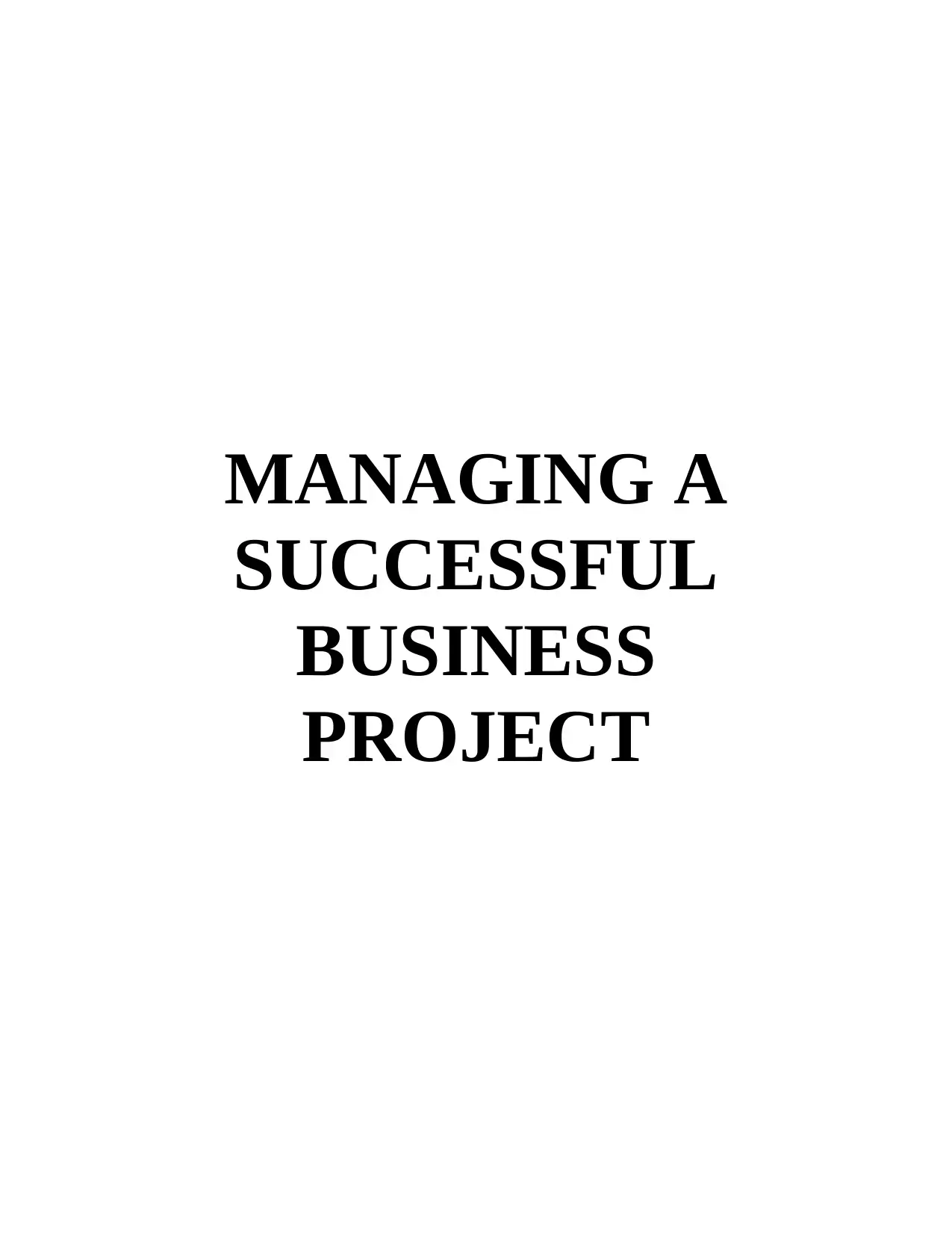
MANAGING A
SUCCESSFUL
BUSINESS
PROJECT
SUCCESSFUL
BUSINESS
PROJECT
Secure Best Marks with AI Grader
Need help grading? Try our AI Grader for instant feedback on your assignments.
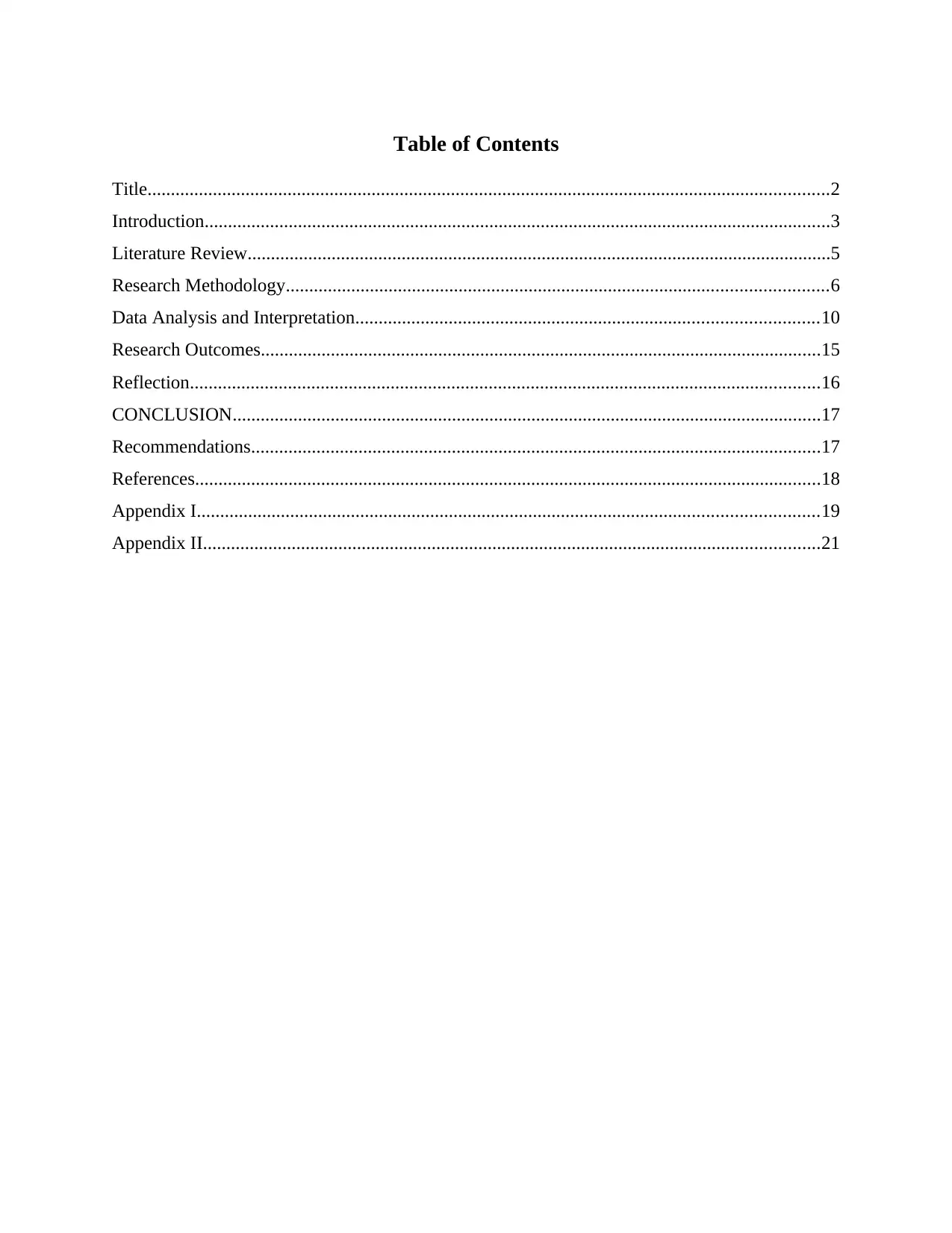
Table of Contents
Title..................................................................................................................................................2
Introduction......................................................................................................................................3
Literature Review.............................................................................................................................5
Research Methodology....................................................................................................................6
Data Analysis and Interpretation...................................................................................................10
Research Outcomes........................................................................................................................15
Reflection.......................................................................................................................................16
CONCLUSION..............................................................................................................................17
Recommendations..........................................................................................................................17
References......................................................................................................................................18
Appendix I.....................................................................................................................................19
Appendix II....................................................................................................................................21
Title..................................................................................................................................................2
Introduction......................................................................................................................................3
Literature Review.............................................................................................................................5
Research Methodology....................................................................................................................6
Data Analysis and Interpretation...................................................................................................10
Research Outcomes........................................................................................................................15
Reflection.......................................................................................................................................16
CONCLUSION..............................................................................................................................17
Recommendations..........................................................................................................................17
References......................................................................................................................................18
Appendix I.....................................................................................................................................19
Appendix II....................................................................................................................................21
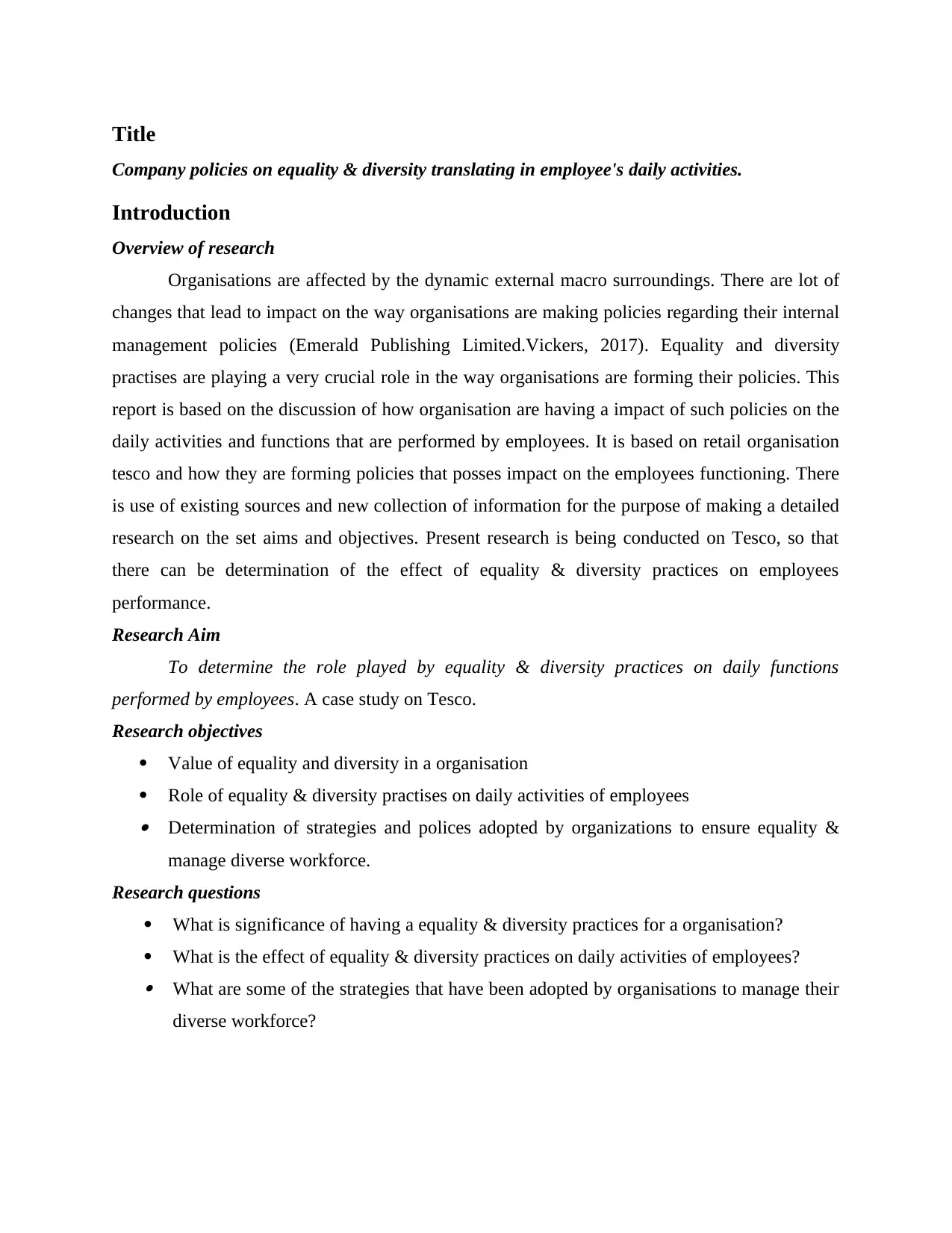
Title
Company policies on equality & diversity translating in employee's daily activities.
Introduction
Overview of research
Organisations are affected by the dynamic external macro surroundings. There are lot of
changes that lead to impact on the way organisations are making policies regarding their internal
management policies (Emerald Publishing Limited.Vickers, 2017). Equality and diversity
practises are playing a very crucial role in the way organisations are forming their policies. This
report is based on the discussion of how organisation are having a impact of such policies on the
daily activities and functions that are performed by employees. It is based on retail organisation
tesco and how they are forming policies that posses impact on the employees functioning. There
is use of existing sources and new collection of information for the purpose of making a detailed
research on the set aims and objectives. Present research is being conducted on Tesco, so that
there can be determination of the effect of equality & diversity practices on employees
performance.
Research Aim
To determine the role played by equality & diversity practices on daily functions
performed by employees. A case study on Tesco.
Research objectives
Value of equality and diversity in a organisation
Role of equality & diversity practises on daily activities of employees Determination of strategies and polices adopted by organizations to ensure equality &
manage diverse workforce.
Research questions
What is significance of having a equality & diversity practices for a organisation?
What is the effect of equality & diversity practices on daily activities of employees? What are some of the strategies that have been adopted by organisations to manage their
diverse workforce?
Company policies on equality & diversity translating in employee's daily activities.
Introduction
Overview of research
Organisations are affected by the dynamic external macro surroundings. There are lot of
changes that lead to impact on the way organisations are making policies regarding their internal
management policies (Emerald Publishing Limited.Vickers, 2017). Equality and diversity
practises are playing a very crucial role in the way organisations are forming their policies. This
report is based on the discussion of how organisation are having a impact of such policies on the
daily activities and functions that are performed by employees. It is based on retail organisation
tesco and how they are forming policies that posses impact on the employees functioning. There
is use of existing sources and new collection of information for the purpose of making a detailed
research on the set aims and objectives. Present research is being conducted on Tesco, so that
there can be determination of the effect of equality & diversity practices on employees
performance.
Research Aim
To determine the role played by equality & diversity practices on daily functions
performed by employees. A case study on Tesco.
Research objectives
Value of equality and diversity in a organisation
Role of equality & diversity practises on daily activities of employees Determination of strategies and polices adopted by organizations to ensure equality &
manage diverse workforce.
Research questions
What is significance of having a equality & diversity practices for a organisation?
What is the effect of equality & diversity practices on daily activities of employees? What are some of the strategies that have been adopted by organisations to manage their
diverse workforce?
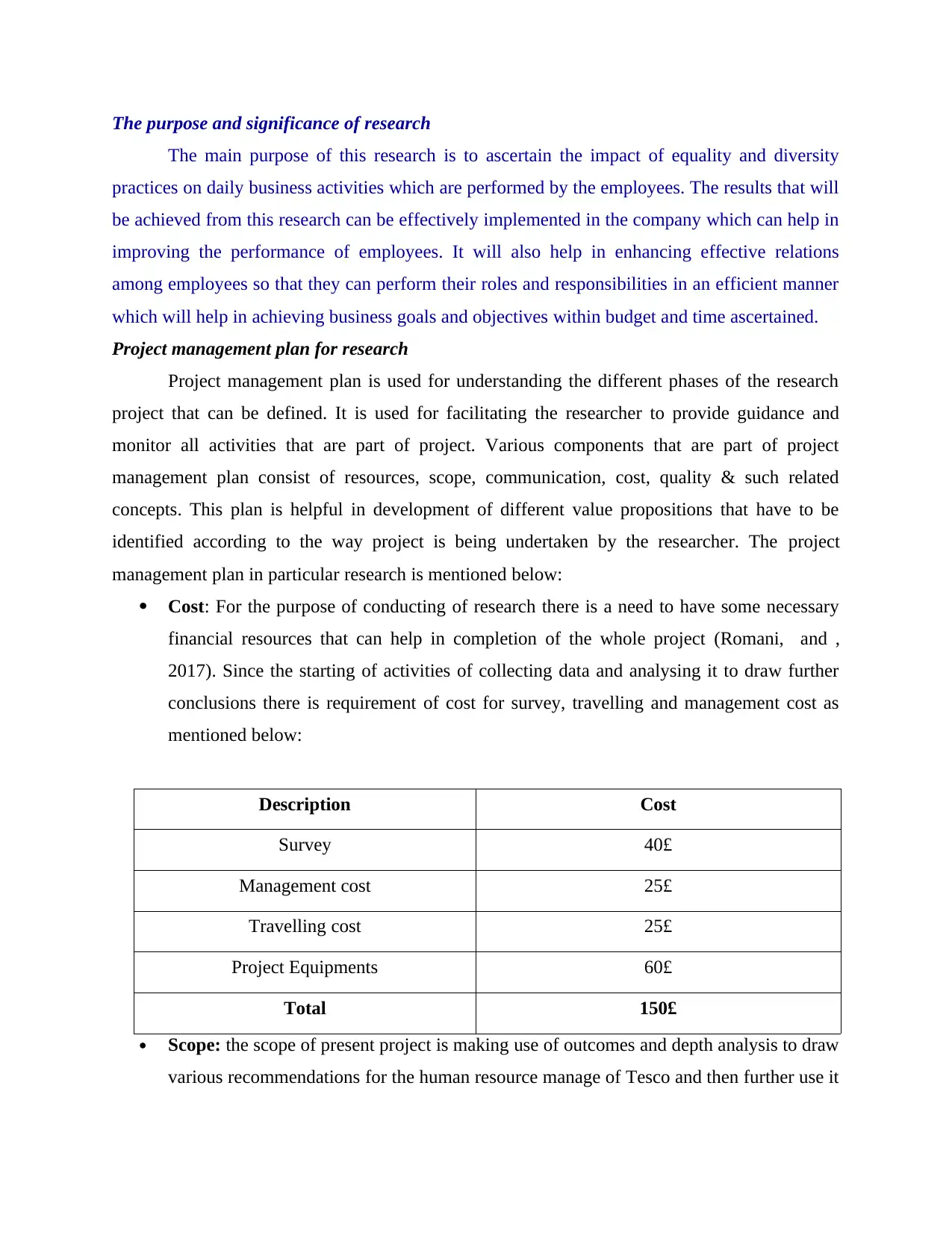
The purpose and significance of research
The main purpose of this research is to ascertain the impact of equality and diversity
practices on daily business activities which are performed by the employees. The results that will
be achieved from this research can be effectively implemented in the company which can help in
improving the performance of employees. It will also help in enhancing effective relations
among employees so that they can perform their roles and responsibilities in an efficient manner
which will help in achieving business goals and objectives within budget and time ascertained.
Project management plan for research
Project management plan is used for understanding the different phases of the research
project that can be defined. It is used for facilitating the researcher to provide guidance and
monitor all activities that are part of project. Various components that are part of project
management plan consist of resources, scope, communication, cost, quality & such related
concepts. This plan is helpful in development of different value propositions that have to be
identified according to the way project is being undertaken by the researcher. The project
management plan in particular research is mentioned below:
Cost: For the purpose of conducting of research there is a need to have some necessary
financial resources that can help in completion of the whole project (Romani, and ,
2017). Since the starting of activities of collecting data and analysing it to draw further
conclusions there is requirement of cost for survey, travelling and management cost as
mentioned below:
Description Cost
Survey 40£
Management cost 25£
Travelling cost 25£
Project Equipments 60£
Total 150£
Scope: the scope of present project is making use of outcomes and depth analysis to draw
various recommendations for the human resource manage of Tesco and then further use it
The main purpose of this research is to ascertain the impact of equality and diversity
practices on daily business activities which are performed by the employees. The results that will
be achieved from this research can be effectively implemented in the company which can help in
improving the performance of employees. It will also help in enhancing effective relations
among employees so that they can perform their roles and responsibilities in an efficient manner
which will help in achieving business goals and objectives within budget and time ascertained.
Project management plan for research
Project management plan is used for understanding the different phases of the research
project that can be defined. It is used for facilitating the researcher to provide guidance and
monitor all activities that are part of project. Various components that are part of project
management plan consist of resources, scope, communication, cost, quality & such related
concepts. This plan is helpful in development of different value propositions that have to be
identified according to the way project is being undertaken by the researcher. The project
management plan in particular research is mentioned below:
Cost: For the purpose of conducting of research there is a need to have some necessary
financial resources that can help in completion of the whole project (Romani, and ,
2017). Since the starting of activities of collecting data and analysing it to draw further
conclusions there is requirement of cost for survey, travelling and management cost as
mentioned below:
Description Cost
Survey 40£
Management cost 25£
Travelling cost 25£
Project Equipments 60£
Total 150£
Scope: the scope of present project is making use of outcomes and depth analysis to draw
various recommendations for the human resource manage of Tesco and then further use it
Secure Best Marks with AI Grader
Need help grading? Try our AI Grader for instant feedback on your assignments.
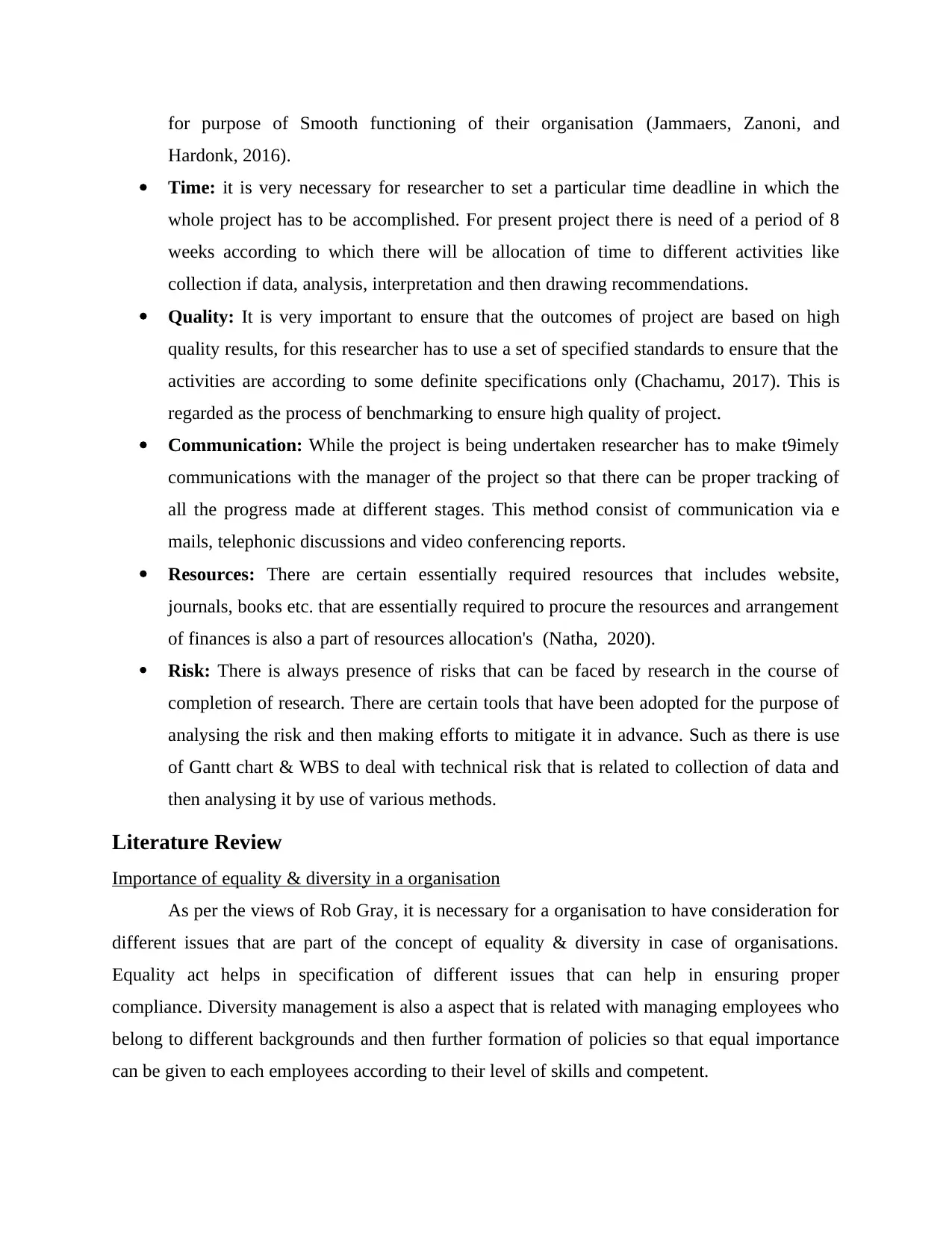
for purpose of Smooth functioning of their organisation (Jammaers, Zanoni, and
Hardonk, 2016).
Time: it is very necessary for researcher to set a particular time deadline in which the
whole project has to be accomplished. For present project there is need of a period of 8
weeks according to which there will be allocation of time to different activities like
collection if data, analysis, interpretation and then drawing recommendations.
Quality: It is very important to ensure that the outcomes of project are based on high
quality results, for this researcher has to use a set of specified standards to ensure that the
activities are according to some definite specifications only (Chachamu, 2017). This is
regarded as the process of benchmarking to ensure high quality of project.
Communication: While the project is being undertaken researcher has to make t9imely
communications with the manager of the project so that there can be proper tracking of
all the progress made at different stages. This method consist of communication via e
mails, telephonic discussions and video conferencing reports.
Resources: There are certain essentially required resources that includes website,
journals, books etc. that are essentially required to procure the resources and arrangement
of finances is also a part of resources allocation's (Natha, 2020).
Risk: There is always presence of risks that can be faced by research in the course of
completion of research. There are certain tools that have been adopted for the purpose of
analysing the risk and then making efforts to mitigate it in advance. Such as there is use
of Gantt chart & WBS to deal with technical risk that is related to collection of data and
then analysing it by use of various methods.
Literature Review
Importance of equality & diversity in a organisation
As per the views of Rob Gray, it is necessary for a organisation to have consideration for
different issues that are part of the concept of equality & diversity in case of organisations.
Equality act helps in specification of different issues that can help in ensuring proper
compliance. Diversity management is also a aspect that is related with managing employees who
belong to different backgrounds and then further formation of policies so that equal importance
can be given to each employees according to their level of skills and competent.
Hardonk, 2016).
Time: it is very necessary for researcher to set a particular time deadline in which the
whole project has to be accomplished. For present project there is need of a period of 8
weeks according to which there will be allocation of time to different activities like
collection if data, analysis, interpretation and then drawing recommendations.
Quality: It is very important to ensure that the outcomes of project are based on high
quality results, for this researcher has to use a set of specified standards to ensure that the
activities are according to some definite specifications only (Chachamu, 2017). This is
regarded as the process of benchmarking to ensure high quality of project.
Communication: While the project is being undertaken researcher has to make t9imely
communications with the manager of the project so that there can be proper tracking of
all the progress made at different stages. This method consist of communication via e
mails, telephonic discussions and video conferencing reports.
Resources: There are certain essentially required resources that includes website,
journals, books etc. that are essentially required to procure the resources and arrangement
of finances is also a part of resources allocation's (Natha, 2020).
Risk: There is always presence of risks that can be faced by research in the course of
completion of research. There are certain tools that have been adopted for the purpose of
analysing the risk and then making efforts to mitigate it in advance. Such as there is use
of Gantt chart & WBS to deal with technical risk that is related to collection of data and
then analysing it by use of various methods.
Literature Review
Importance of equality & diversity in a organisation
As per the views of Rob Gray, it is necessary for a organisation to have consideration for
different issues that are part of the concept of equality & diversity in case of organisations.
Equality act helps in specification of different issues that can help in ensuring proper
compliance. Diversity management is also a aspect that is related with managing employees who
belong to different backgrounds and then further formation of policies so that equal importance
can be given to each employees according to their level of skills and competent.
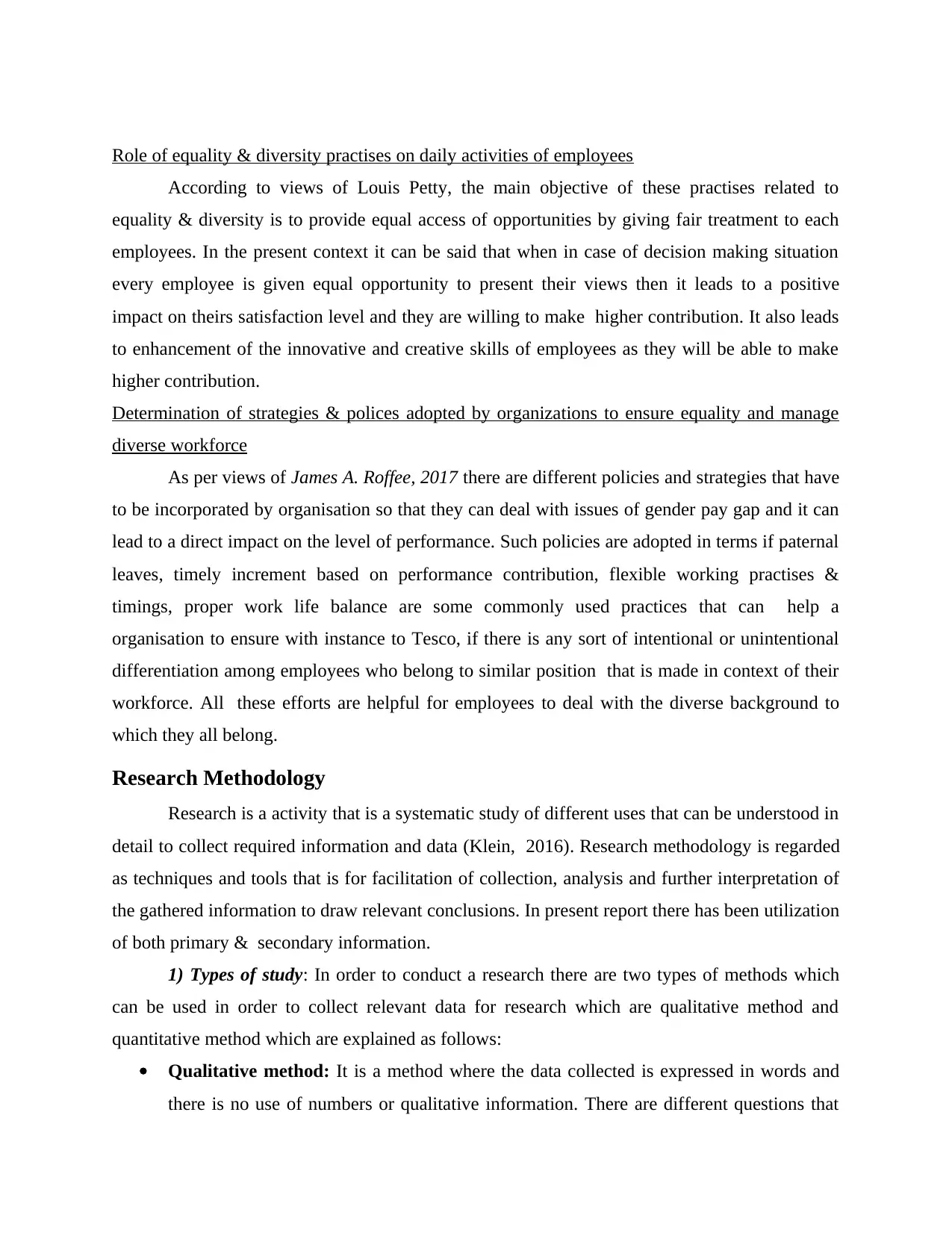
Role of equality & diversity practises on daily activities of employees
According to views of Louis Petty, the main objective of these practises related to
equality & diversity is to provide equal access of opportunities by giving fair treatment to each
employees. In the present context it can be said that when in case of decision making situation
every employee is given equal opportunity to present their views then it leads to a positive
impact on theirs satisfaction level and they are willing to make higher contribution. It also leads
to enhancement of the innovative and creative skills of employees as they will be able to make
higher contribution.
Determination of strategies & polices adopted by organizations to ensure equality and manage
diverse workforce
As per views of James A. Roffee, 2017 there are different policies and strategies that have
to be incorporated by organisation so that they can deal with issues of gender pay gap and it can
lead to a direct impact on the level of performance. Such policies are adopted in terms if paternal
leaves, timely increment based on performance contribution, flexible working practises &
timings, proper work life balance are some commonly used practices that can help a
organisation to ensure with instance to Tesco, if there is any sort of intentional or unintentional
differentiation among employees who belong to similar position that is made in context of their
workforce. All these efforts are helpful for employees to deal with the diverse background to
which they all belong.
Research Methodology
Research is a activity that is a systematic study of different uses that can be understood in
detail to collect required information and data (Klein, 2016). Research methodology is regarded
as techniques and tools that is for facilitation of collection, analysis and further interpretation of
the gathered information to draw relevant conclusions. In present report there has been utilization
of both primary & secondary information.
1) Types of study: In order to conduct a research there are two types of methods which
can be used in order to collect relevant data for research which are qualitative method and
quantitative method which are explained as follows:
Qualitative method: It is a method where the data collected is expressed in words and
there is no use of numbers or qualitative information. There are different questions that
According to views of Louis Petty, the main objective of these practises related to
equality & diversity is to provide equal access of opportunities by giving fair treatment to each
employees. In the present context it can be said that when in case of decision making situation
every employee is given equal opportunity to present their views then it leads to a positive
impact on theirs satisfaction level and they are willing to make higher contribution. It also leads
to enhancement of the innovative and creative skills of employees as they will be able to make
higher contribution.
Determination of strategies & polices adopted by organizations to ensure equality and manage
diverse workforce
As per views of James A. Roffee, 2017 there are different policies and strategies that have
to be incorporated by organisation so that they can deal with issues of gender pay gap and it can
lead to a direct impact on the level of performance. Such policies are adopted in terms if paternal
leaves, timely increment based on performance contribution, flexible working practises &
timings, proper work life balance are some commonly used practices that can help a
organisation to ensure with instance to Tesco, if there is any sort of intentional or unintentional
differentiation among employees who belong to similar position that is made in context of their
workforce. All these efforts are helpful for employees to deal with the diverse background to
which they all belong.
Research Methodology
Research is a activity that is a systematic study of different uses that can be understood in
detail to collect required information and data (Klein, 2016). Research methodology is regarded
as techniques and tools that is for facilitation of collection, analysis and further interpretation of
the gathered information to draw relevant conclusions. In present report there has been utilization
of both primary & secondary information.
1) Types of study: In order to conduct a research there are two types of methods which
can be used in order to collect relevant data for research which are qualitative method and
quantitative method which are explained as follows:
Qualitative method: It is a method where the data collected is expressed in words and
there is no use of numbers or qualitative information. There are different questions that
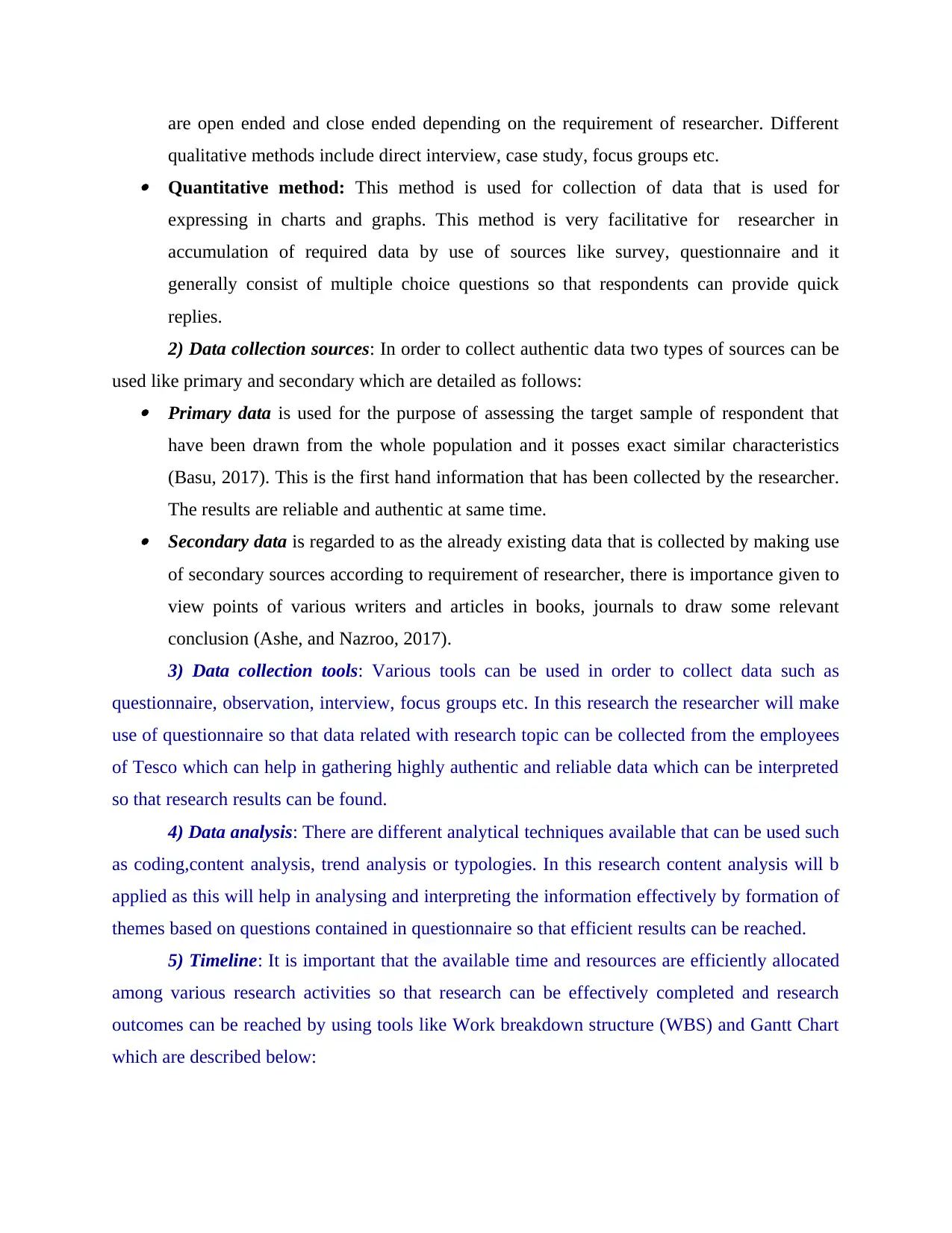
are open ended and close ended depending on the requirement of researcher. Different
qualitative methods include direct interview, case study, focus groups etc. Quantitative method: This method is used for collection of data that is used for
expressing in charts and graphs. This method is very facilitative for researcher in
accumulation of required data by use of sources like survey, questionnaire and it
generally consist of multiple choice questions so that respondents can provide quick
replies.
2) Data collection sources: In order to collect authentic data two types of sources can be
used like primary and secondary which are detailed as follows: Primary data is used for the purpose of assessing the target sample of respondent that
have been drawn from the whole population and it posses exact similar characteristics
(Basu, 2017). This is the first hand information that has been collected by the researcher.
The results are reliable and authentic at same time. Secondary data is regarded to as the already existing data that is collected by making use
of secondary sources according to requirement of researcher, there is importance given to
view points of various writers and articles in books, journals to draw some relevant
conclusion (Ashe, and Nazroo, 2017).
3) Data collection tools: Various tools can be used in order to collect data such as
questionnaire, observation, interview, focus groups etc. In this research the researcher will make
use of questionnaire so that data related with research topic can be collected from the employees
of Tesco which can help in gathering highly authentic and reliable data which can be interpreted
so that research results can be found.
4) Data analysis: There are different analytical techniques available that can be used such
as coding,content analysis, trend analysis or typologies. In this research content analysis will b
applied as this will help in analysing and interpreting the information effectively by formation of
themes based on questions contained in questionnaire so that efficient results can be reached.
5) Timeline: It is important that the available time and resources are efficiently allocated
among various research activities so that research can be effectively completed and research
outcomes can be reached by using tools like Work breakdown structure (WBS) and Gantt Chart
which are described below:
qualitative methods include direct interview, case study, focus groups etc. Quantitative method: This method is used for collection of data that is used for
expressing in charts and graphs. This method is very facilitative for researcher in
accumulation of required data by use of sources like survey, questionnaire and it
generally consist of multiple choice questions so that respondents can provide quick
replies.
2) Data collection sources: In order to collect authentic data two types of sources can be
used like primary and secondary which are detailed as follows: Primary data is used for the purpose of assessing the target sample of respondent that
have been drawn from the whole population and it posses exact similar characteristics
(Basu, 2017). This is the first hand information that has been collected by the researcher.
The results are reliable and authentic at same time. Secondary data is regarded to as the already existing data that is collected by making use
of secondary sources according to requirement of researcher, there is importance given to
view points of various writers and articles in books, journals to draw some relevant
conclusion (Ashe, and Nazroo, 2017).
3) Data collection tools: Various tools can be used in order to collect data such as
questionnaire, observation, interview, focus groups etc. In this research the researcher will make
use of questionnaire so that data related with research topic can be collected from the employees
of Tesco which can help in gathering highly authentic and reliable data which can be interpreted
so that research results can be found.
4) Data analysis: There are different analytical techniques available that can be used such
as coding,content analysis, trend analysis or typologies. In this research content analysis will b
applied as this will help in analysing and interpreting the information effectively by formation of
themes based on questions contained in questionnaire so that efficient results can be reached.
5) Timeline: It is important that the available time and resources are efficiently allocated
among various research activities so that research can be effectively completed and research
outcomes can be reached by using tools like Work breakdown structure (WBS) and Gantt Chart
which are described below:
Paraphrase This Document
Need a fresh take? Get an instant paraphrase of this document with our AI Paraphraser
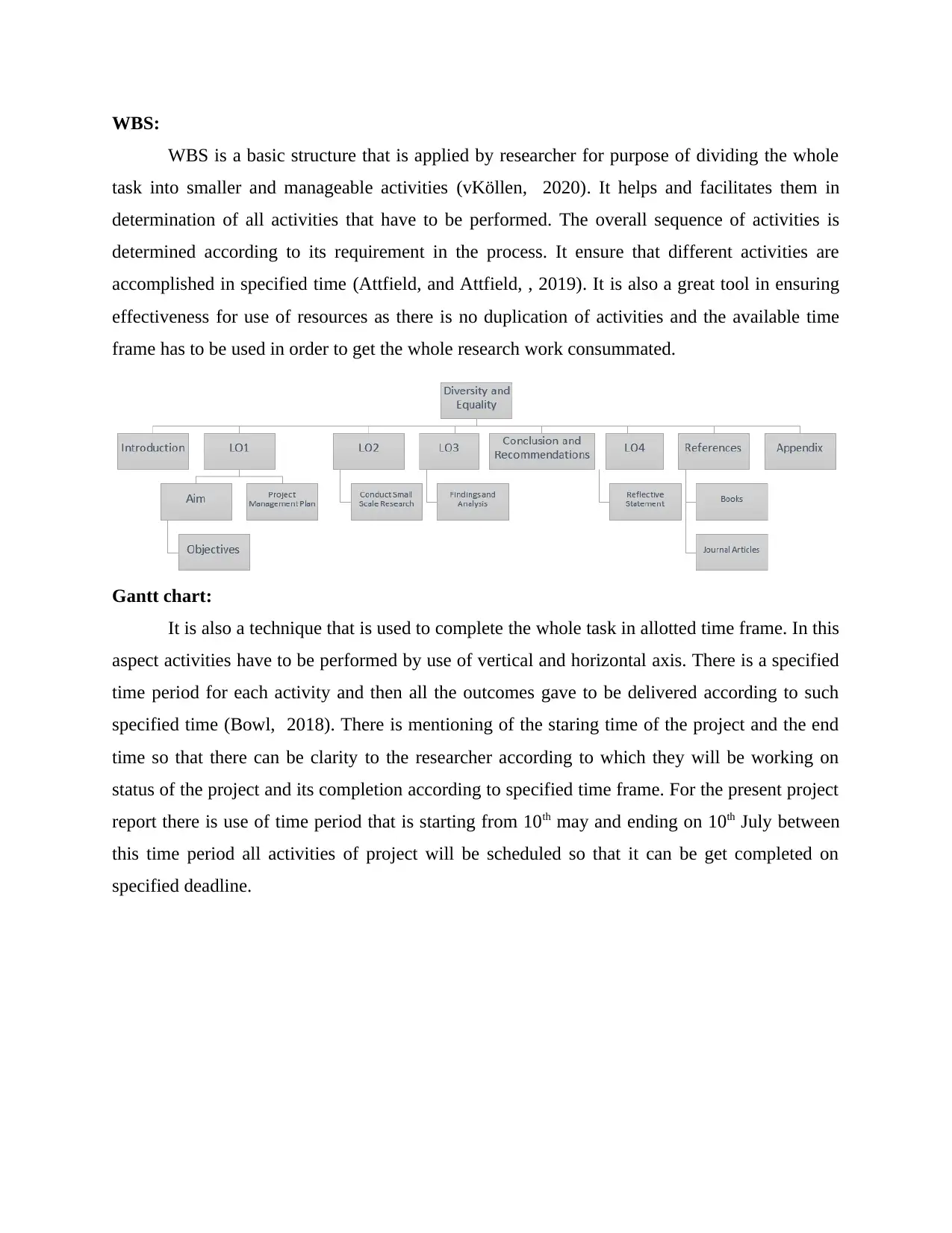
WBS:
WBS is a basic structure that is applied by researcher for purpose of dividing the whole
task into smaller and manageable activities (vKöllen, 2020). It helps and facilitates them in
determination of all activities that have to be performed. The overall sequence of activities is
determined according to its requirement in the process. It ensure that different activities are
accomplished in specified time (Attfield, and Attfield, , 2019). It is also a great tool in ensuring
effectiveness for use of resources as there is no duplication of activities and the available time
frame has to be used in order to get the whole research work consummated.
Gantt chart:
It is also a technique that is used to complete the whole task in allotted time frame. In this
aspect activities have to be performed by use of vertical and horizontal axis. There is a specified
time period for each activity and then all the outcomes gave to be delivered according to such
specified time (Bowl, 2018). There is mentioning of the staring time of the project and the end
time so that there can be clarity to the researcher according to which they will be working on
status of the project and its completion according to specified time frame. For the present project
report there is use of time period that is starting from 10th may and ending on 10th July between
this time period all activities of project will be scheduled so that it can be get completed on
specified deadline.
WBS is a basic structure that is applied by researcher for purpose of dividing the whole
task into smaller and manageable activities (vKöllen, 2020). It helps and facilitates them in
determination of all activities that have to be performed. The overall sequence of activities is
determined according to its requirement in the process. It ensure that different activities are
accomplished in specified time (Attfield, and Attfield, , 2019). It is also a great tool in ensuring
effectiveness for use of resources as there is no duplication of activities and the available time
frame has to be used in order to get the whole research work consummated.
Gantt chart:
It is also a technique that is used to complete the whole task in allotted time frame. In this
aspect activities have to be performed by use of vertical and horizontal axis. There is a specified
time period for each activity and then all the outcomes gave to be delivered according to such
specified time (Bowl, 2018). There is mentioning of the staring time of the project and the end
time so that there can be clarity to the researcher according to which they will be working on
status of the project and its completion according to specified time frame. For the present project
report there is use of time period that is starting from 10th may and ending on 10th July between
this time period all activities of project will be scheduled so that it can be get completed on
specified deadline.
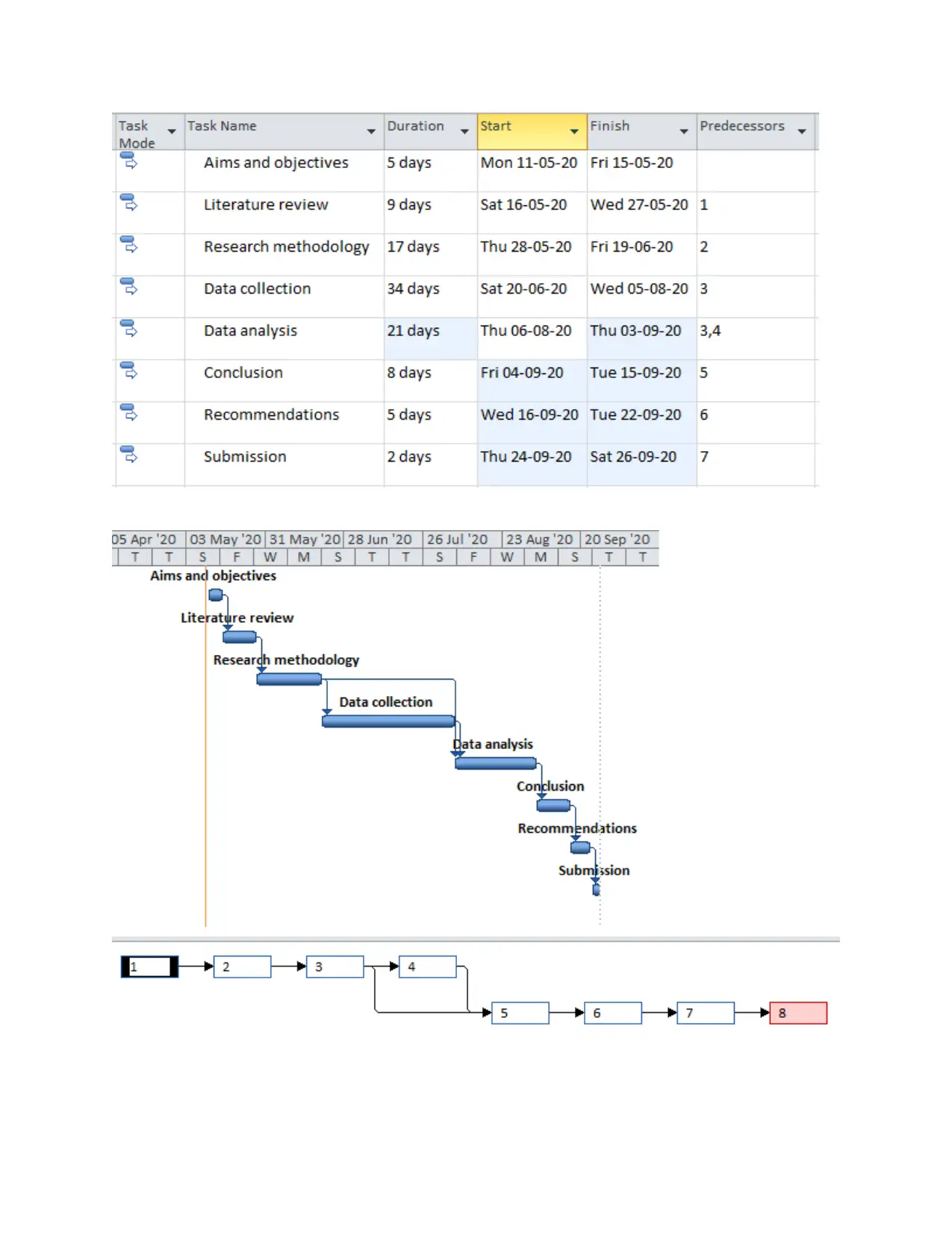
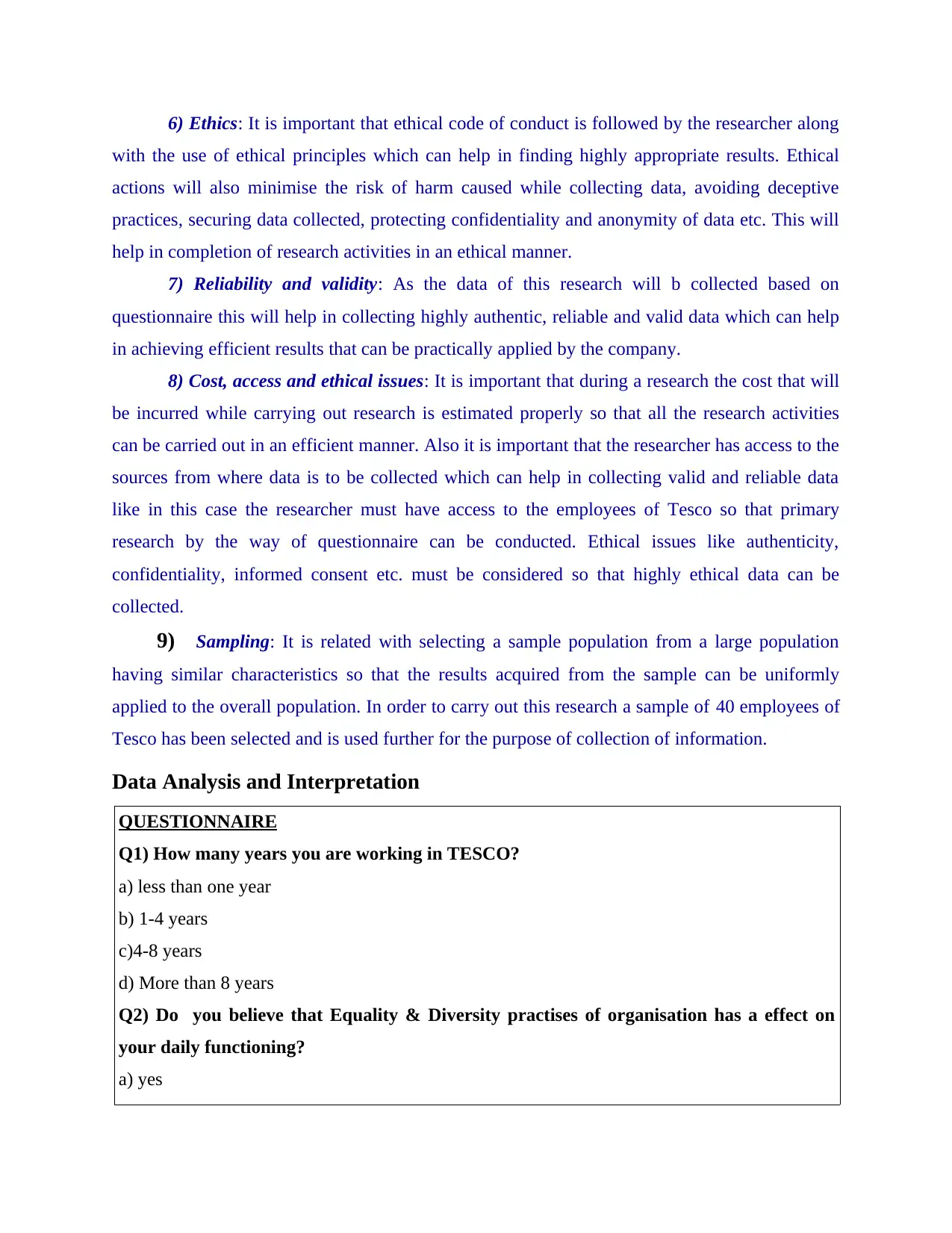
6) Ethics: It is important that ethical code of conduct is followed by the researcher along
with the use of ethical principles which can help in finding highly appropriate results. Ethical
actions will also minimise the risk of harm caused while collecting data, avoiding deceptive
practices, securing data collected, protecting confidentiality and anonymity of data etc. This will
help in completion of research activities in an ethical manner.
7) Reliability and validity: As the data of this research will b collected based on
questionnaire this will help in collecting highly authentic, reliable and valid data which can help
in achieving efficient results that can be practically applied by the company.
8) Cost, access and ethical issues: It is important that during a research the cost that will
be incurred while carrying out research is estimated properly so that all the research activities
can be carried out in an efficient manner. Also it is important that the researcher has access to the
sources from where data is to be collected which can help in collecting valid and reliable data
like in this case the researcher must have access to the employees of Tesco so that primary
research by the way of questionnaire can be conducted. Ethical issues like authenticity,
confidentiality, informed consent etc. must be considered so that highly ethical data can be
collected.
9) Sampling: It is related with selecting a sample population from a large population
having similar characteristics so that the results acquired from the sample can be uniformly
applied to the overall population. In order to carry out this research a sample of 40 employees of
Tesco has been selected and is used further for the purpose of collection of information.
Data Analysis and Interpretation
QUESTIONNAIRE
Q1) How many years you are working in TESCO?
a) less than one year
b) 1-4 years
c)4-8 years
d) More than 8 years
Q2) Do you believe that Equality & Diversity practises of organisation has a effect on
your daily functioning?
a) yes
with the use of ethical principles which can help in finding highly appropriate results. Ethical
actions will also minimise the risk of harm caused while collecting data, avoiding deceptive
practices, securing data collected, protecting confidentiality and anonymity of data etc. This will
help in completion of research activities in an ethical manner.
7) Reliability and validity: As the data of this research will b collected based on
questionnaire this will help in collecting highly authentic, reliable and valid data which can help
in achieving efficient results that can be practically applied by the company.
8) Cost, access and ethical issues: It is important that during a research the cost that will
be incurred while carrying out research is estimated properly so that all the research activities
can be carried out in an efficient manner. Also it is important that the researcher has access to the
sources from where data is to be collected which can help in collecting valid and reliable data
like in this case the researcher must have access to the employees of Tesco so that primary
research by the way of questionnaire can be conducted. Ethical issues like authenticity,
confidentiality, informed consent etc. must be considered so that highly ethical data can be
collected.
9) Sampling: It is related with selecting a sample population from a large population
having similar characteristics so that the results acquired from the sample can be uniformly
applied to the overall population. In order to carry out this research a sample of 40 employees of
Tesco has been selected and is used further for the purpose of collection of information.
Data Analysis and Interpretation
QUESTIONNAIRE
Q1) How many years you are working in TESCO?
a) less than one year
b) 1-4 years
c)4-8 years
d) More than 8 years
Q2) Do you believe that Equality & Diversity practises of organisation has a effect on
your daily functioning?
a) yes
Secure Best Marks with AI Grader
Need help grading? Try our AI Grader for instant feedback on your assignments.
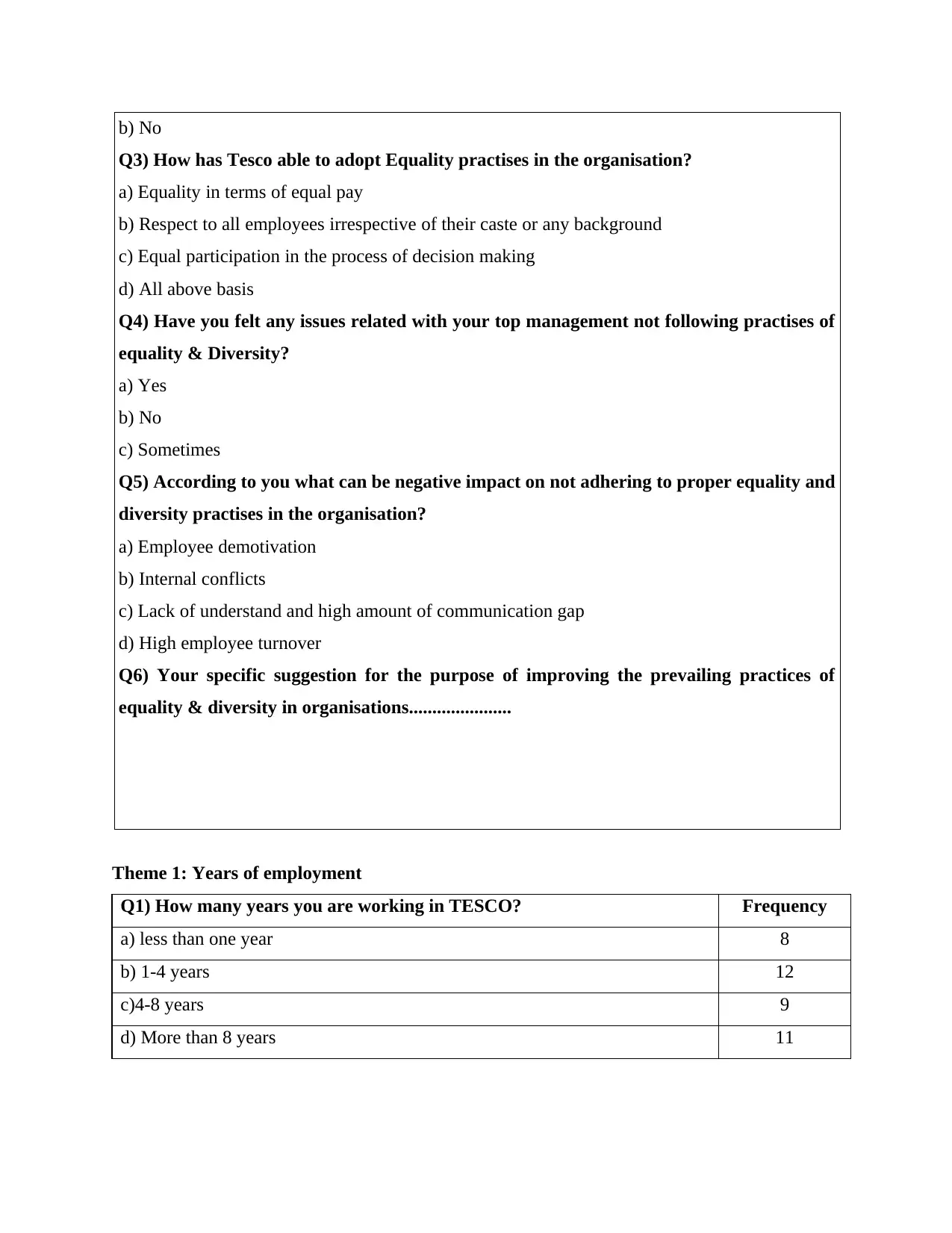
b) No
Q3) How has Tesco able to adopt Equality practises in the organisation?
a) Equality in terms of equal pay
b) Respect to all employees irrespective of their caste or any background
c) Equal participation in the process of decision making
d) All above basis
Q4) Have you felt any issues related with your top management not following practises of
equality & Diversity?
a) Yes
b) No
c) Sometimes
Q5) According to you what can be negative impact on not adhering to proper equality and
diversity practises in the organisation?
a) Employee demotivation
b) Internal conflicts
c) Lack of understand and high amount of communication gap
d) High employee turnover
Q6) Your specific suggestion for the purpose of improving the prevailing practices of
equality & diversity in organisations......................
Theme 1: Years of employment
Q1) How many years you are working in TESCO? Frequency
a) less than one year 8
b) 1-4 years 12
c)4-8 years 9
d) More than 8 years 11
Q3) How has Tesco able to adopt Equality practises in the organisation?
a) Equality in terms of equal pay
b) Respect to all employees irrespective of their caste or any background
c) Equal participation in the process of decision making
d) All above basis
Q4) Have you felt any issues related with your top management not following practises of
equality & Diversity?
a) Yes
b) No
c) Sometimes
Q5) According to you what can be negative impact on not adhering to proper equality and
diversity practises in the organisation?
a) Employee demotivation
b) Internal conflicts
c) Lack of understand and high amount of communication gap
d) High employee turnover
Q6) Your specific suggestion for the purpose of improving the prevailing practices of
equality & diversity in organisations......................
Theme 1: Years of employment
Q1) How many years you are working in TESCO? Frequency
a) less than one year 8
b) 1-4 years 12
c)4-8 years 9
d) More than 8 years 11
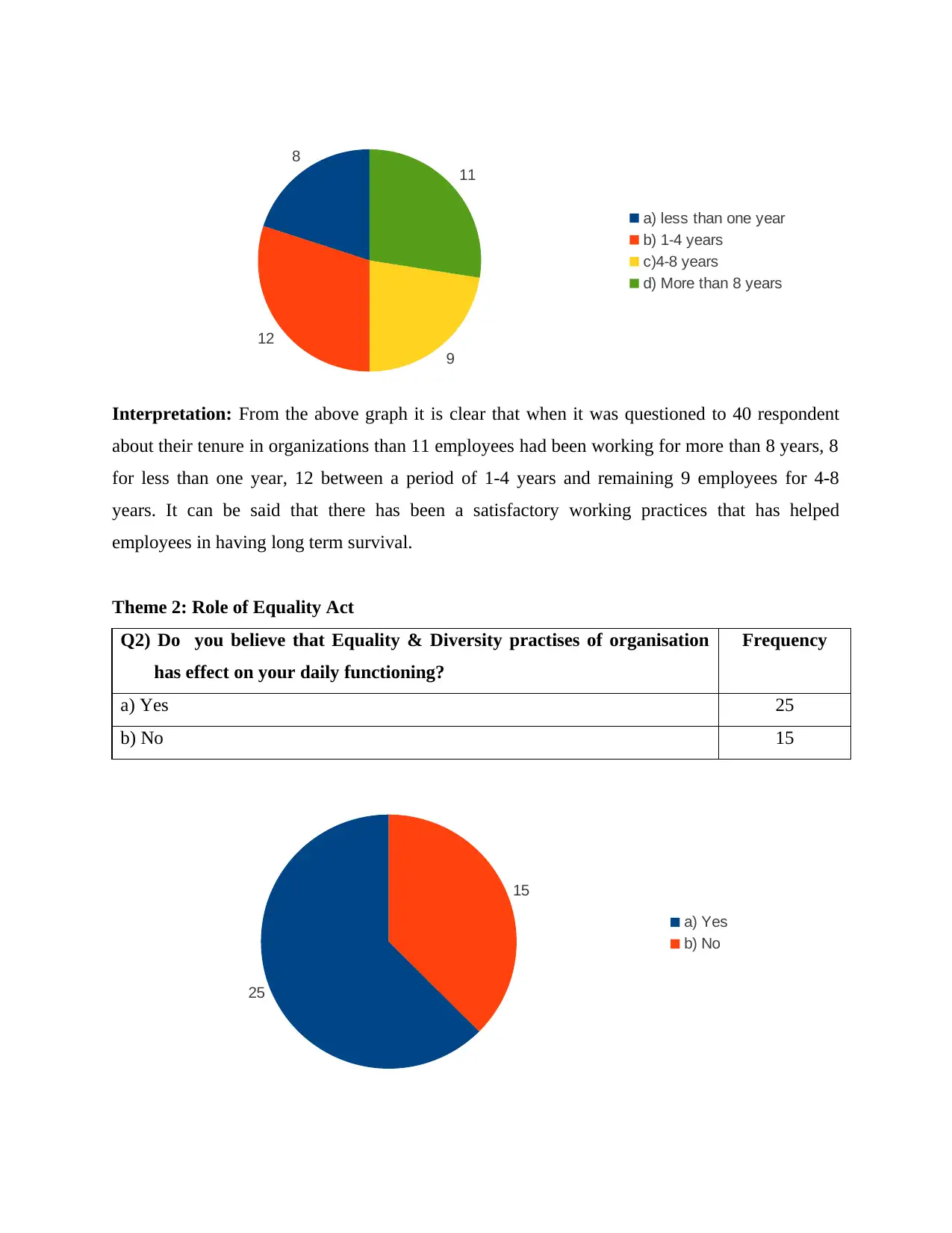
8
12
9
11
a) less than one year
b) 1-4 years
c)4-8 years
d) More than 8 years
Interpretation: From the above graph it is clear that when it was questioned to 40 respondent
about their tenure in organizations than 11 employees had been working for more than 8 years, 8
for less than one year, 12 between a period of 1-4 years and remaining 9 employees for 4-8
years. It can be said that there has been a satisfactory working practices that has helped
employees in having long term survival.
Theme 2: Role of Equality Act
Q2) Do you believe that Equality & Diversity practises of organisation
has effect on your daily functioning?
Frequency
a) Yes 25
b) No 15
25
15
a) Yes
b) No
12
9
11
a) less than one year
b) 1-4 years
c)4-8 years
d) More than 8 years
Interpretation: From the above graph it is clear that when it was questioned to 40 respondent
about their tenure in organizations than 11 employees had been working for more than 8 years, 8
for less than one year, 12 between a period of 1-4 years and remaining 9 employees for 4-8
years. It can be said that there has been a satisfactory working practices that has helped
employees in having long term survival.
Theme 2: Role of Equality Act
Q2) Do you believe that Equality & Diversity practises of organisation
has effect on your daily functioning?
Frequency
a) Yes 25
b) No 15
25
15
a) Yes
b) No
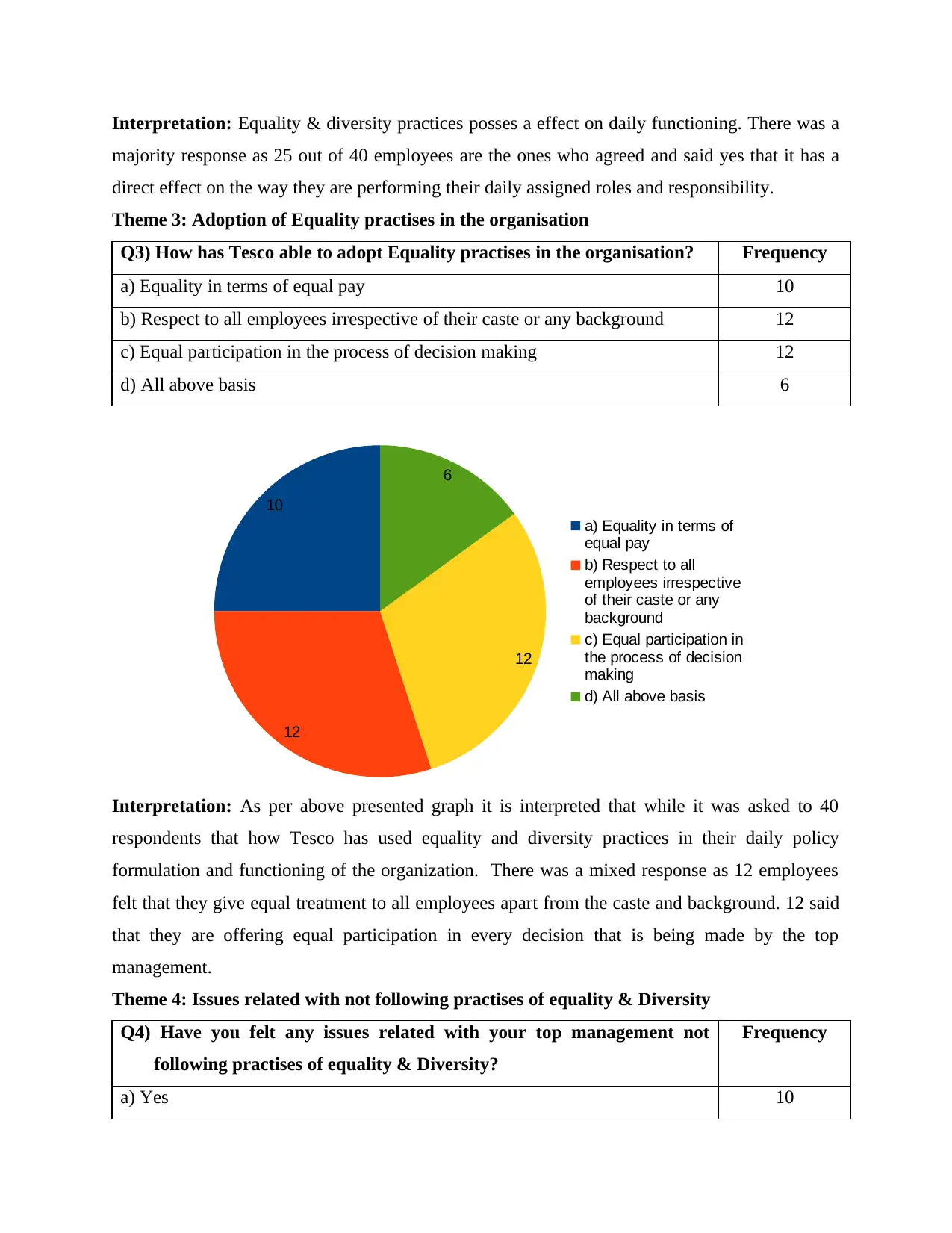
Interpretation: Equality & diversity practices posses a effect on daily functioning. There was a
majority response as 25 out of 40 employees are the ones who agreed and said yes that it has a
direct effect on the way they are performing their daily assigned roles and responsibility.
Theme 3: Adoption of Equality practises in the organisation
Q3) How has Tesco able to adopt Equality practises in the organisation? Frequency
a) Equality in terms of equal pay 10
b) Respect to all employees irrespective of their caste or any background 12
c) Equal participation in the process of decision making 12
d) All above basis 6
Interpretation: As per above presented graph it is interpreted that while it was asked to 40
respondents that how Tesco has used equality and diversity practices in their daily policy
formulation and functioning of the organization. There was a mixed response as 12 employees
felt that they give equal treatment to all employees apart from the caste and background. 12 said
that they are offering equal participation in every decision that is being made by the top
management.
Theme 4: Issues related with not following practises of equality & Diversity
Q4) Have you felt any issues related with your top management not
following practises of equality & Diversity?
Frequency
a) Yes 10
10
12
12
6
a) Equality in terms of
equal pay
b) Respect to all
employees irrespective
of their caste or any
background
c) Equal participation in
the process of decision
making
d) All above basis
majority response as 25 out of 40 employees are the ones who agreed and said yes that it has a
direct effect on the way they are performing their daily assigned roles and responsibility.
Theme 3: Adoption of Equality practises in the organisation
Q3) How has Tesco able to adopt Equality practises in the organisation? Frequency
a) Equality in terms of equal pay 10
b) Respect to all employees irrespective of their caste or any background 12
c) Equal participation in the process of decision making 12
d) All above basis 6
Interpretation: As per above presented graph it is interpreted that while it was asked to 40
respondents that how Tesco has used equality and diversity practices in their daily policy
formulation and functioning of the organization. There was a mixed response as 12 employees
felt that they give equal treatment to all employees apart from the caste and background. 12 said
that they are offering equal participation in every decision that is being made by the top
management.
Theme 4: Issues related with not following practises of equality & Diversity
Q4) Have you felt any issues related with your top management not
following practises of equality & Diversity?
Frequency
a) Yes 10
10
12
12
6
a) Equality in terms of
equal pay
b) Respect to all
employees irrespective
of their caste or any
background
c) Equal participation in
the process of decision
making
d) All above basis
Paraphrase This Document
Need a fresh take? Get an instant paraphrase of this document with our AI Paraphraser
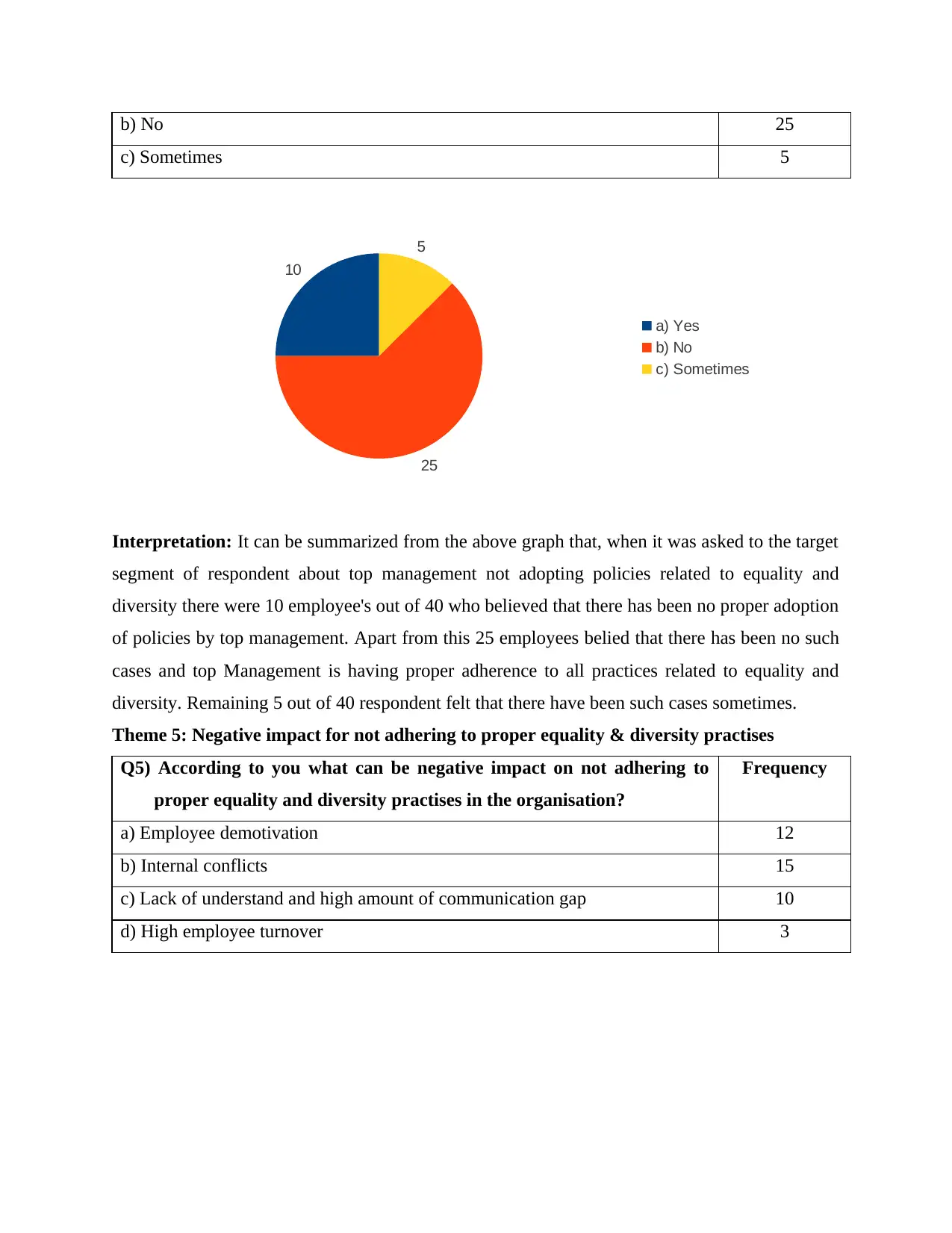
b) No 25
c) Sometimes 5
10
25
5
a) Yes
b) No
c) Sometimes
Interpretation: It can be summarized from the above graph that, when it was asked to the target
segment of respondent about top management not adopting policies related to equality and
diversity there were 10 employee's out of 40 who believed that there has been no proper adoption
of policies by top management. Apart from this 25 employees belied that there has been no such
cases and top Management is having proper adherence to all practices related to equality and
diversity. Remaining 5 out of 40 respondent felt that there have been such cases sometimes.
Theme 5: Negative impact for not adhering to proper equality & diversity practises
Q5) According to you what can be negative impact on not adhering to
proper equality and diversity practises in the organisation?
Frequency
a) Employee demotivation 12
b) Internal conflicts 15
c) Lack of understand and high amount of communication gap 10
d) High employee turnover 3
c) Sometimes 5
10
25
5
a) Yes
b) No
c) Sometimes
Interpretation: It can be summarized from the above graph that, when it was asked to the target
segment of respondent about top management not adopting policies related to equality and
diversity there were 10 employee's out of 40 who believed that there has been no proper adoption
of policies by top management. Apart from this 25 employees belied that there has been no such
cases and top Management is having proper adherence to all practices related to equality and
diversity. Remaining 5 out of 40 respondent felt that there have been such cases sometimes.
Theme 5: Negative impact for not adhering to proper equality & diversity practises
Q5) According to you what can be negative impact on not adhering to
proper equality and diversity practises in the organisation?
Frequency
a) Employee demotivation 12
b) Internal conflicts 15
c) Lack of understand and high amount of communication gap 10
d) High employee turnover 3
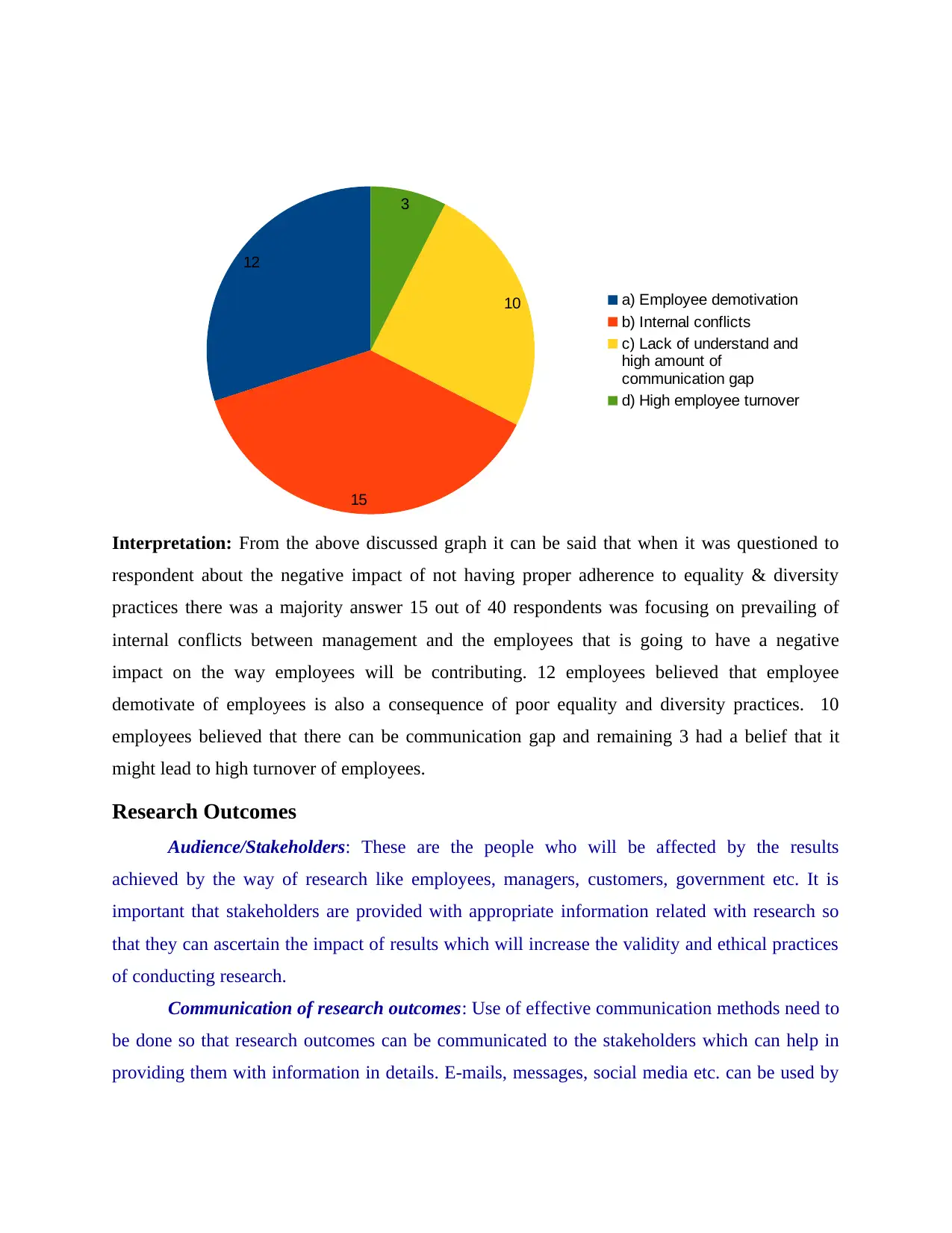
Interpretation: From the above discussed graph it can be said that when it was questioned to
respondent about the negative impact of not having proper adherence to equality & diversity
practices there was a majority answer 15 out of 40 respondents was focusing on prevailing of
internal conflicts between management and the employees that is going to have a negative
impact on the way employees will be contributing. 12 employees believed that employee
demotivate of employees is also a consequence of poor equality and diversity practices. 10
employees believed that there can be communication gap and remaining 3 had a belief that it
might lead to high turnover of employees.
Research Outcomes
Audience/Stakeholders: These are the people who will be affected by the results
achieved by the way of research like employees, managers, customers, government etc. It is
important that stakeholders are provided with appropriate information related with research so
that they can ascertain the impact of results which will increase the validity and ethical practices
of conducting research.
Communication of research outcomes: Use of effective communication methods need to
be done so that research outcomes can be communicated to the stakeholders which can help in
providing them with information in details. E-mails, messages, social media etc. can be used by
12
15
10
3
a) Employee demotivation
b) Internal conflicts
c) Lack of understand and
high amount of
communication gap
d) High employee turnover
respondent about the negative impact of not having proper adherence to equality & diversity
practices there was a majority answer 15 out of 40 respondents was focusing on prevailing of
internal conflicts between management and the employees that is going to have a negative
impact on the way employees will be contributing. 12 employees believed that employee
demotivate of employees is also a consequence of poor equality and diversity practices. 10
employees believed that there can be communication gap and remaining 3 had a belief that it
might lead to high turnover of employees.
Research Outcomes
Audience/Stakeholders: These are the people who will be affected by the results
achieved by the way of research like employees, managers, customers, government etc. It is
important that stakeholders are provided with appropriate information related with research so
that they can ascertain the impact of results which will increase the validity and ethical practices
of conducting research.
Communication of research outcomes: Use of effective communication methods need to
be done so that research outcomes can be communicated to the stakeholders which can help in
providing them with information in details. E-mails, messages, social media etc. can be used by
12
15
10
3
a) Employee demotivation
b) Internal conflicts
c) Lack of understand and
high amount of
communication gap
d) High employee turnover
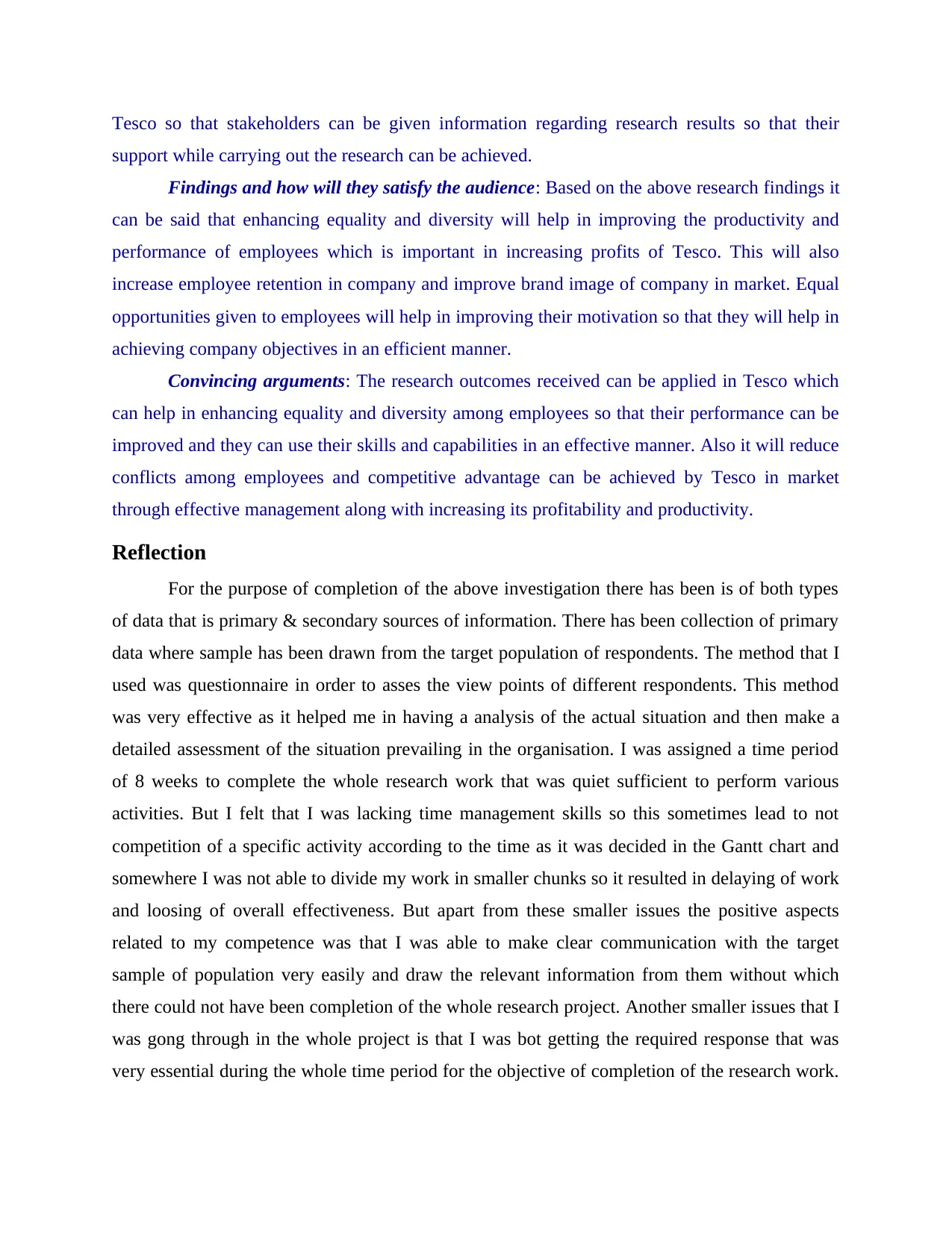
Tesco so that stakeholders can be given information regarding research results so that their
support while carrying out the research can be achieved.
Findings and how will they satisfy the audience: Based on the above research findings it
can be said that enhancing equality and diversity will help in improving the productivity and
performance of employees which is important in increasing profits of Tesco. This will also
increase employee retention in company and improve brand image of company in market. Equal
opportunities given to employees will help in improving their motivation so that they will help in
achieving company objectives in an efficient manner.
Convincing arguments: The research outcomes received can be applied in Tesco which
can help in enhancing equality and diversity among employees so that their performance can be
improved and they can use their skills and capabilities in an effective manner. Also it will reduce
conflicts among employees and competitive advantage can be achieved by Tesco in market
through effective management along with increasing its profitability and productivity.
Reflection
For the purpose of completion of the above investigation there has been is of both types
of data that is primary & secondary sources of information. There has been collection of primary
data where sample has been drawn from the target population of respondents. The method that I
used was questionnaire in order to asses the view points of different respondents. This method
was very effective as it helped me in having a analysis of the actual situation and then make a
detailed assessment of the situation prevailing in the organisation. I was assigned a time period
of 8 weeks to complete the whole research work that was quiet sufficient to perform various
activities. But I felt that I was lacking time management skills so this sometimes lead to not
competition of a specific activity according to the time as it was decided in the Gantt chart and
somewhere I was not able to divide my work in smaller chunks so it resulted in delaying of work
and loosing of overall effectiveness. But apart from these smaller issues the positive aspects
related to my competence was that I was able to make clear communication with the target
sample of population very easily and draw the relevant information from them without which
there could not have been completion of the whole research project. Another smaller issues that I
was gong through in the whole project is that I was bot getting the required response that was
very essential during the whole time period for the objective of completion of the research work.
support while carrying out the research can be achieved.
Findings and how will they satisfy the audience: Based on the above research findings it
can be said that enhancing equality and diversity will help in improving the productivity and
performance of employees which is important in increasing profits of Tesco. This will also
increase employee retention in company and improve brand image of company in market. Equal
opportunities given to employees will help in improving their motivation so that they will help in
achieving company objectives in an efficient manner.
Convincing arguments: The research outcomes received can be applied in Tesco which
can help in enhancing equality and diversity among employees so that their performance can be
improved and they can use their skills and capabilities in an effective manner. Also it will reduce
conflicts among employees and competitive advantage can be achieved by Tesco in market
through effective management along with increasing its profitability and productivity.
Reflection
For the purpose of completion of the above investigation there has been is of both types
of data that is primary & secondary sources of information. There has been collection of primary
data where sample has been drawn from the target population of respondents. The method that I
used was questionnaire in order to asses the view points of different respondents. This method
was very effective as it helped me in having a analysis of the actual situation and then make a
detailed assessment of the situation prevailing in the organisation. I was assigned a time period
of 8 weeks to complete the whole research work that was quiet sufficient to perform various
activities. But I felt that I was lacking time management skills so this sometimes lead to not
competition of a specific activity according to the time as it was decided in the Gantt chart and
somewhere I was not able to divide my work in smaller chunks so it resulted in delaying of work
and loosing of overall effectiveness. But apart from these smaller issues the positive aspects
related to my competence was that I was able to make clear communication with the target
sample of population very easily and draw the relevant information from them without which
there could not have been completion of the whole research project. Another smaller issues that I
was gong through in the whole project is that I was bot getting the required response that was
very essential during the whole time period for the objective of completion of the research work.
Secure Best Marks with AI Grader
Need help grading? Try our AI Grader for instant feedback on your assignments.
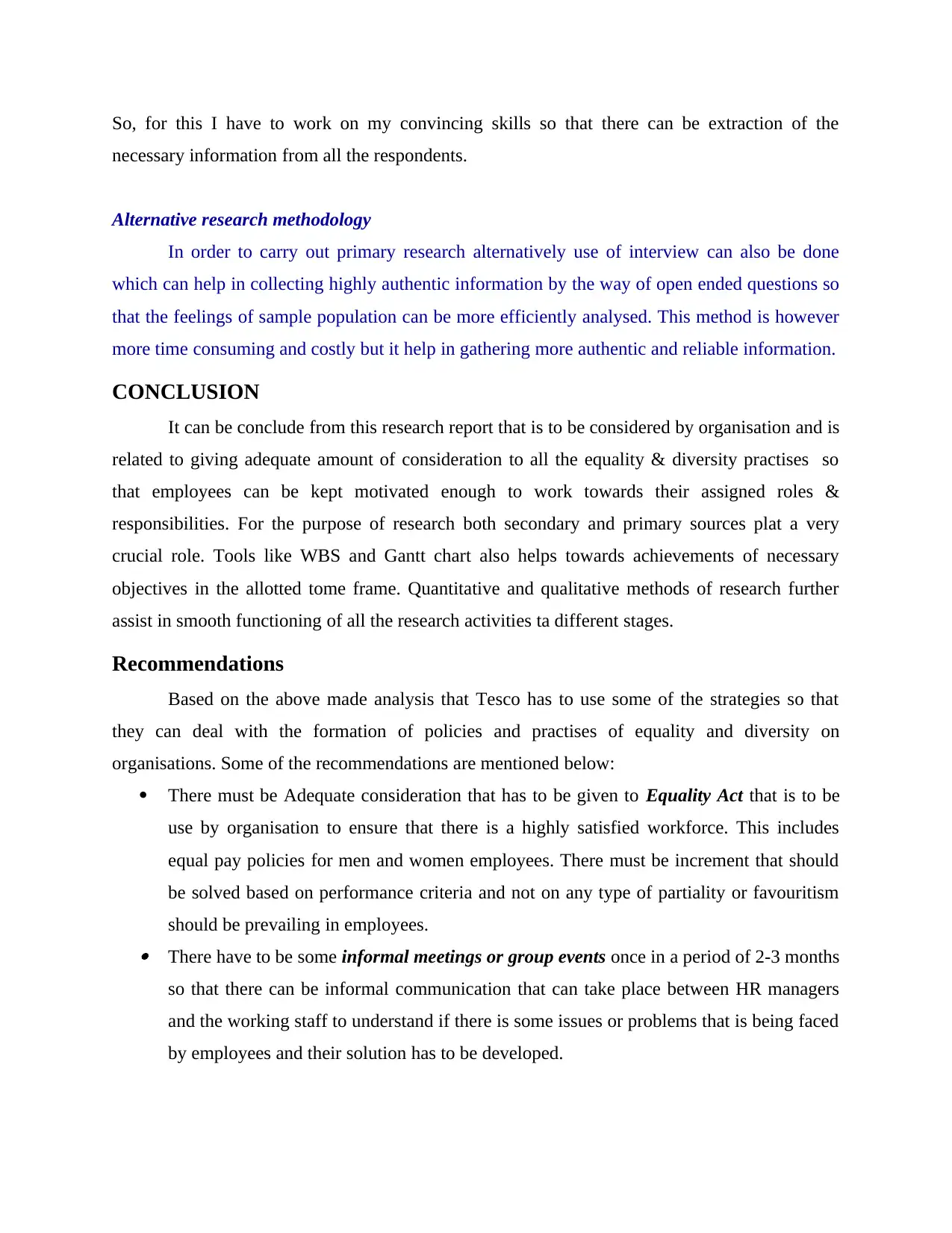
So, for this I have to work on my convincing skills so that there can be extraction of the
necessary information from all the respondents.
Alternative research methodology
In order to carry out primary research alternatively use of interview can also be done
which can help in collecting highly authentic information by the way of open ended questions so
that the feelings of sample population can be more efficiently analysed. This method is however
more time consuming and costly but it help in gathering more authentic and reliable information.
CONCLUSION
It can be conclude from this research report that is to be considered by organisation and is
related to giving adequate amount of consideration to all the equality & diversity practises so
that employees can be kept motivated enough to work towards their assigned roles &
responsibilities. For the purpose of research both secondary and primary sources plat a very
crucial role. Tools like WBS and Gantt chart also helps towards achievements of necessary
objectives in the allotted tome frame. Quantitative and qualitative methods of research further
assist in smooth functioning of all the research activities ta different stages.
Recommendations
Based on the above made analysis that Tesco has to use some of the strategies so that
they can deal with the formation of policies and practises of equality and diversity on
organisations. Some of the recommendations are mentioned below:
There must be Adequate consideration that has to be given to Equality Act that is to be
use by organisation to ensure that there is a highly satisfied workforce. This includes
equal pay policies for men and women employees. There must be increment that should
be solved based on performance criteria and not on any type of partiality or favouritism
should be prevailing in employees. There have to be some informal meetings or group events once in a period of 2-3 months
so that there can be informal communication that can take place between HR managers
and the working staff to understand if there is some issues or problems that is being faced
by employees and their solution has to be developed.
necessary information from all the respondents.
Alternative research methodology
In order to carry out primary research alternatively use of interview can also be done
which can help in collecting highly authentic information by the way of open ended questions so
that the feelings of sample population can be more efficiently analysed. This method is however
more time consuming and costly but it help in gathering more authentic and reliable information.
CONCLUSION
It can be conclude from this research report that is to be considered by organisation and is
related to giving adequate amount of consideration to all the equality & diversity practises so
that employees can be kept motivated enough to work towards their assigned roles &
responsibilities. For the purpose of research both secondary and primary sources plat a very
crucial role. Tools like WBS and Gantt chart also helps towards achievements of necessary
objectives in the allotted tome frame. Quantitative and qualitative methods of research further
assist in smooth functioning of all the research activities ta different stages.
Recommendations
Based on the above made analysis that Tesco has to use some of the strategies so that
they can deal with the formation of policies and practises of equality and diversity on
organisations. Some of the recommendations are mentioned below:
There must be Adequate consideration that has to be given to Equality Act that is to be
use by organisation to ensure that there is a highly satisfied workforce. This includes
equal pay policies for men and women employees. There must be increment that should
be solved based on performance criteria and not on any type of partiality or favouritism
should be prevailing in employees. There have to be some informal meetings or group events once in a period of 2-3 months
so that there can be informal communication that can take place between HR managers
and the working staff to understand if there is some issues or problems that is being faced
by employees and their solution has to be developed.
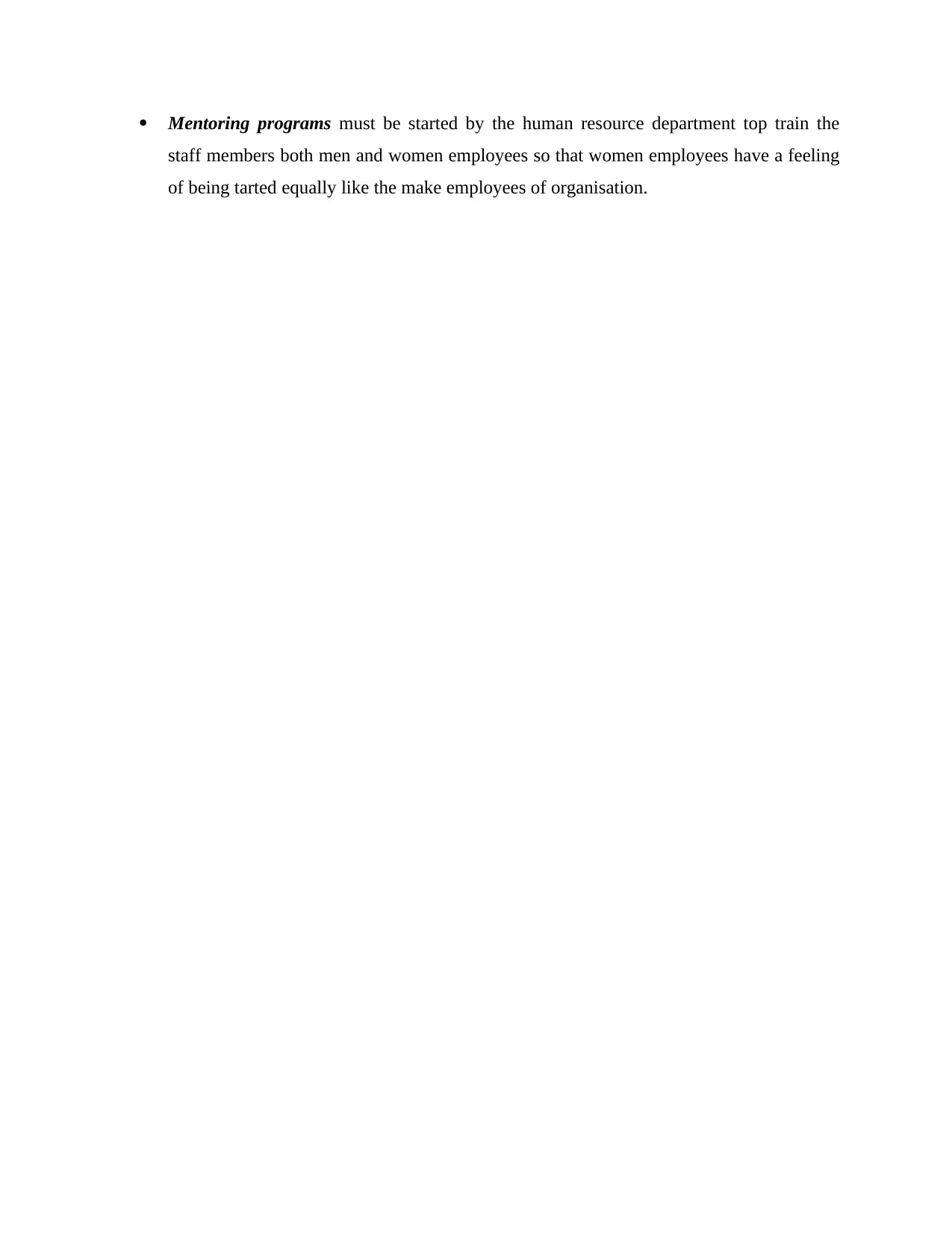
Mentoring programs must be started by the human resource department top train the
staff members both men and women employees so that women employees have a feeling
of being tarted equally like the make employees of organisation.
staff members both men and women employees so that women employees have a feeling
of being tarted equally like the make employees of organisation.
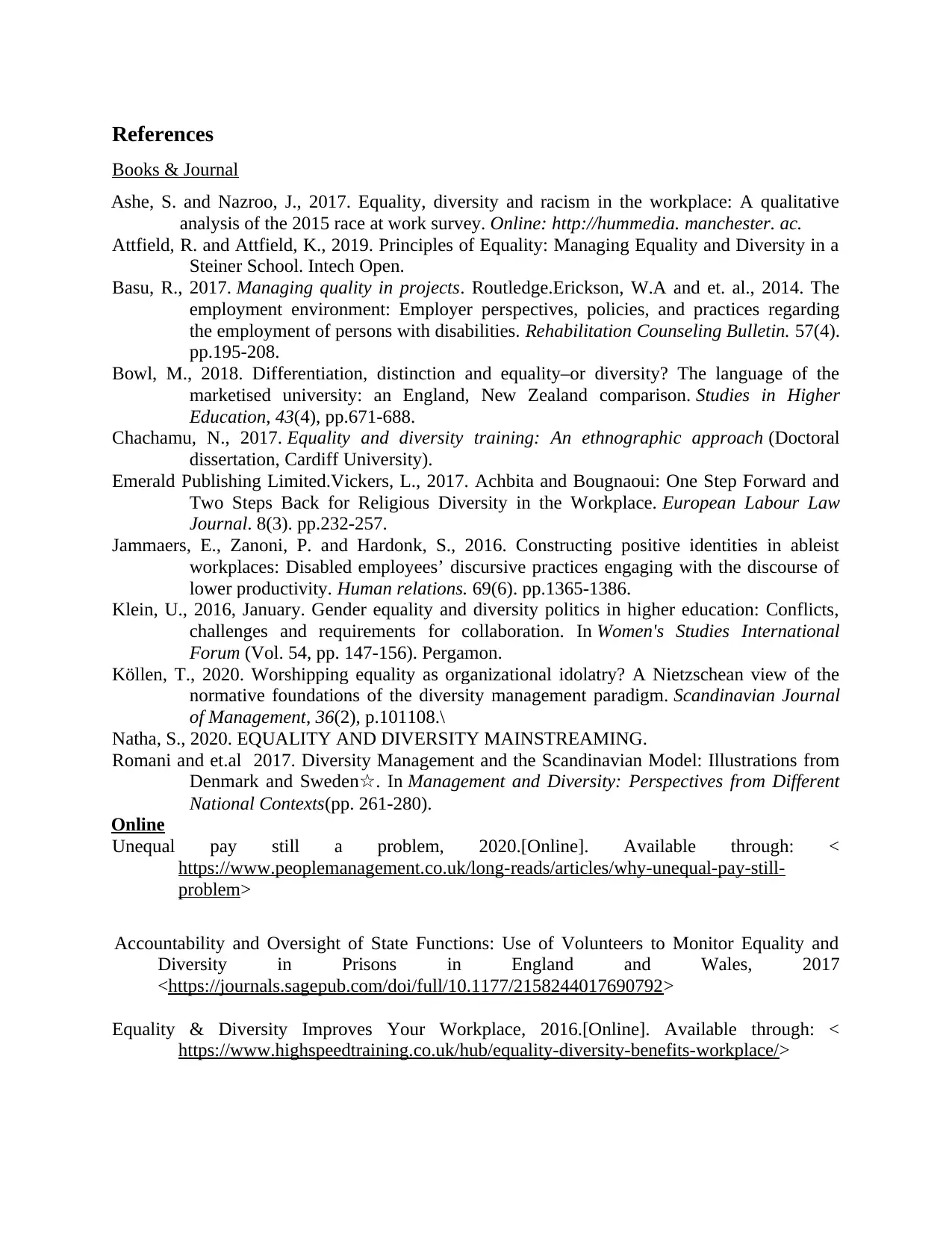
References
Books & Journal
Ashe, S. and Nazroo, J., 2017. Equality, diversity and racism in the workplace: A qualitative
analysis of the 2015 race at work survey. Online: http://hummedia. manchester. ac.
Attfield, R. and Attfield, K., 2019. Principles of Equality: Managing Equality and Diversity in a
Steiner School. Intech Open.
Basu, R., 2017. Managing quality in projects. Routledge.Erickson, W.A and et. al., 2014. The
employment environment: Employer perspectives, policies, and practices regarding
the employment of persons with disabilities. Rehabilitation Counseling Bulletin. 57(4).
pp.195-208.
Bowl, M., 2018. Differentiation, distinction and equality–or diversity? The language of the
marketised university: an England, New Zealand comparison. Studies in Higher
Education, 43(4), pp.671-688.
Chachamu, N., 2017. Equality and diversity training: An ethnographic approach (Doctoral
dissertation, Cardiff University).
Emerald Publishing Limited.Vickers, L., 2017. Achbita and Bougnaoui: One Step Forward and
Two Steps Back for Religious Diversity in the Workplace. European Labour Law
Journal. 8(3). pp.232-257.
Jammaers, E., Zanoni, P. and Hardonk, S., 2016. Constructing positive identities in ableist
workplaces: Disabled employees’ discursive practices engaging with the discourse of
lower productivity. Human relations. 69(6). pp.1365-1386.
Klein, U., 2016, January. Gender equality and diversity politics in higher education: Conflicts,
challenges and requirements for collaboration. In Women's Studies International
Forum (Vol. 54, pp. 147-156). Pergamon.
Köllen, T., 2020. Worshipping equality as organizational idolatry? A Nietzschean view of the
normative foundations of the diversity management paradigm. Scandinavian Journal
of Management, 36(2), p.101108.\
Natha, S., 2020. EQUALITY AND DIVERSITY MAINSTREAMING.
Romani and et.al 2017. Diversity Management and the Scandinavian Model: Illustrations from
Denmark and Sweden☆. In Management and Diversity: Perspectives from Different
National Contexts(pp. 261-280).
Online
Unequal pay still a problem, 2020.[Online]. Available through: <
https://www.peoplemanagement.co.uk/long-reads/articles/why-unequal-pay-still-
problem>
Accountability and Oversight of State Functions: Use of Volunteers to Monitor Equality and
Diversity in Prisons in England and Wales, 2017
<https://journals.sagepub.com/doi/full/10.1177/2158244017690792>
Equality & Diversity Improves Your Workplace, 2016.[Online]. Available through: <
https://www.highspeedtraining.co.uk/hub/equality-diversity-benefits-workplace/>
Books & Journal
Ashe, S. and Nazroo, J., 2017. Equality, diversity and racism in the workplace: A qualitative
analysis of the 2015 race at work survey. Online: http://hummedia. manchester. ac.
Attfield, R. and Attfield, K., 2019. Principles of Equality: Managing Equality and Diversity in a
Steiner School. Intech Open.
Basu, R., 2017. Managing quality in projects. Routledge.Erickson, W.A and et. al., 2014. The
employment environment: Employer perspectives, policies, and practices regarding
the employment of persons with disabilities. Rehabilitation Counseling Bulletin. 57(4).
pp.195-208.
Bowl, M., 2018. Differentiation, distinction and equality–or diversity? The language of the
marketised university: an England, New Zealand comparison. Studies in Higher
Education, 43(4), pp.671-688.
Chachamu, N., 2017. Equality and diversity training: An ethnographic approach (Doctoral
dissertation, Cardiff University).
Emerald Publishing Limited.Vickers, L., 2017. Achbita and Bougnaoui: One Step Forward and
Two Steps Back for Religious Diversity in the Workplace. European Labour Law
Journal. 8(3). pp.232-257.
Jammaers, E., Zanoni, P. and Hardonk, S., 2016. Constructing positive identities in ableist
workplaces: Disabled employees’ discursive practices engaging with the discourse of
lower productivity. Human relations. 69(6). pp.1365-1386.
Klein, U., 2016, January. Gender equality and diversity politics in higher education: Conflicts,
challenges and requirements for collaboration. In Women's Studies International
Forum (Vol. 54, pp. 147-156). Pergamon.
Köllen, T., 2020. Worshipping equality as organizational idolatry? A Nietzschean view of the
normative foundations of the diversity management paradigm. Scandinavian Journal
of Management, 36(2), p.101108.\
Natha, S., 2020. EQUALITY AND DIVERSITY MAINSTREAMING.
Romani and et.al 2017. Diversity Management and the Scandinavian Model: Illustrations from
Denmark and Sweden☆. In Management and Diversity: Perspectives from Different
National Contexts(pp. 261-280).
Online
Unequal pay still a problem, 2020.[Online]. Available through: <
https://www.peoplemanagement.co.uk/long-reads/articles/why-unequal-pay-still-
problem>
Accountability and Oversight of State Functions: Use of Volunteers to Monitor Equality and
Diversity in Prisons in England and Wales, 2017
<https://journals.sagepub.com/doi/full/10.1177/2158244017690792>
Equality & Diversity Improves Your Workplace, 2016.[Online]. Available through: <
https://www.highspeedtraining.co.uk/hub/equality-diversity-benefits-workplace/>
Paraphrase This Document
Need a fresh take? Get an instant paraphrase of this document with our AI Paraphraser
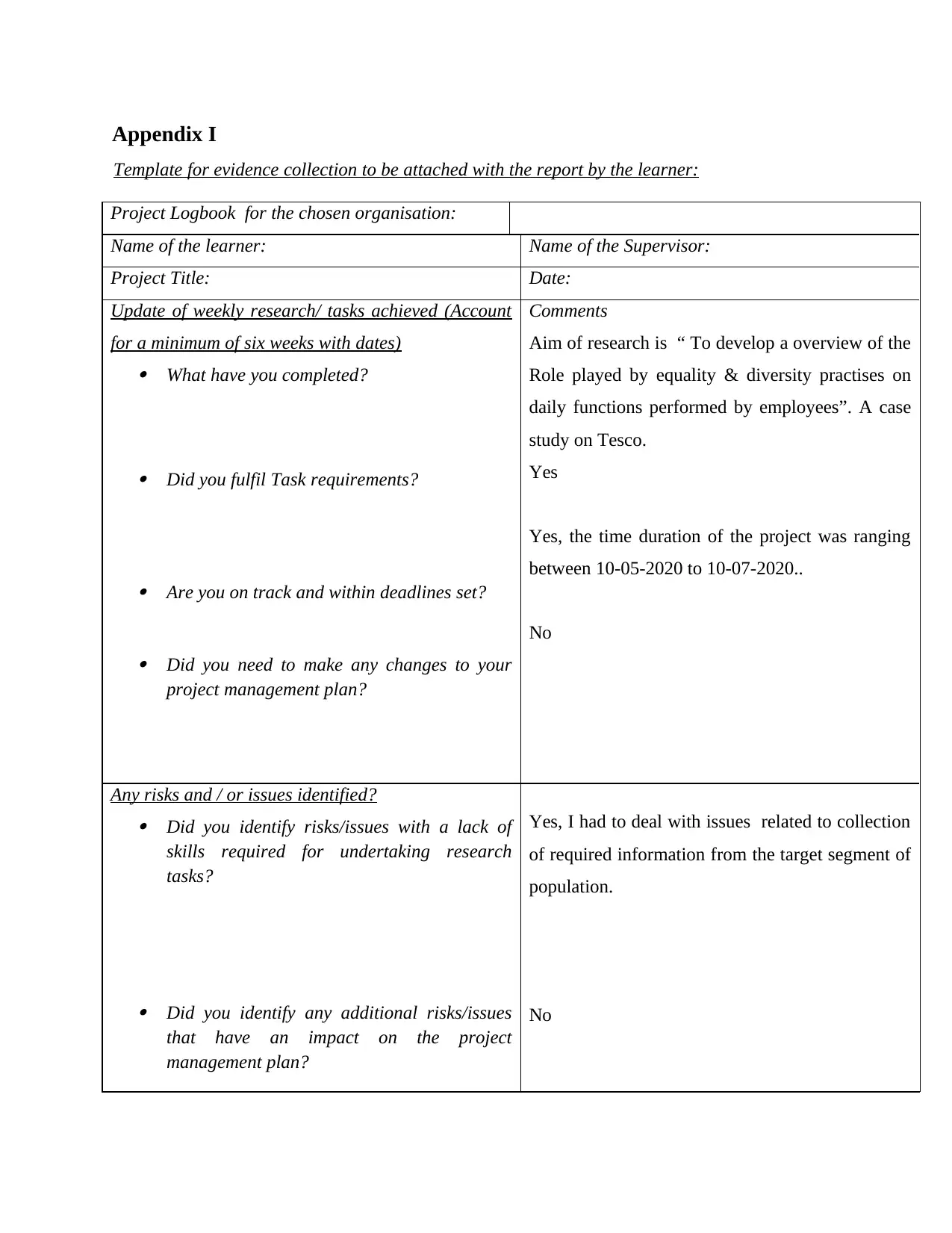
Appendix I
Template for evidence collection to be attached with the report by the learner:
Project Logbook for the chosen organisation:
Name of the learner: Name of the Supervisor:
Project Title: Date:
Update of weekly research/ tasks achieved (Account
for a minimum of six weeks with dates) What have you completed?
Did you fulfil Task requirements?
Are you on track and within deadlines set?
Did you need to make any changes to your
project management plan?
Comments
Aim of research is “ To develop a overview of the
Role played by equality & diversity practises on
daily functions performed by employees”. A case
study on Tesco.
Yes
Yes, the time duration of the project was ranging
between 10-05-2020 to 10-07-2020..
No
Any risks and / or issues identified? Did you identify risks/issues with a lack of
skills required for undertaking research
tasks?
Did you identify any additional risks/issues
that have an impact on the project
management plan?
Yes, I had to deal with issues related to collection
of required information from the target segment of
population.
No
Template for evidence collection to be attached with the report by the learner:
Project Logbook for the chosen organisation:
Name of the learner: Name of the Supervisor:
Project Title: Date:
Update of weekly research/ tasks achieved (Account
for a minimum of six weeks with dates) What have you completed?
Did you fulfil Task requirements?
Are you on track and within deadlines set?
Did you need to make any changes to your
project management plan?
Comments
Aim of research is “ To develop a overview of the
Role played by equality & diversity practises on
daily functions performed by employees”. A case
study on Tesco.
Yes
Yes, the time duration of the project was ranging
between 10-05-2020 to 10-07-2020..
No
Any risks and / or issues identified? Did you identify risks/issues with a lack of
skills required for undertaking research
tasks?
Did you identify any additional risks/issues
that have an impact on the project
management plan?
Yes, I had to deal with issues related to collection
of required information from the target segment of
population.
No
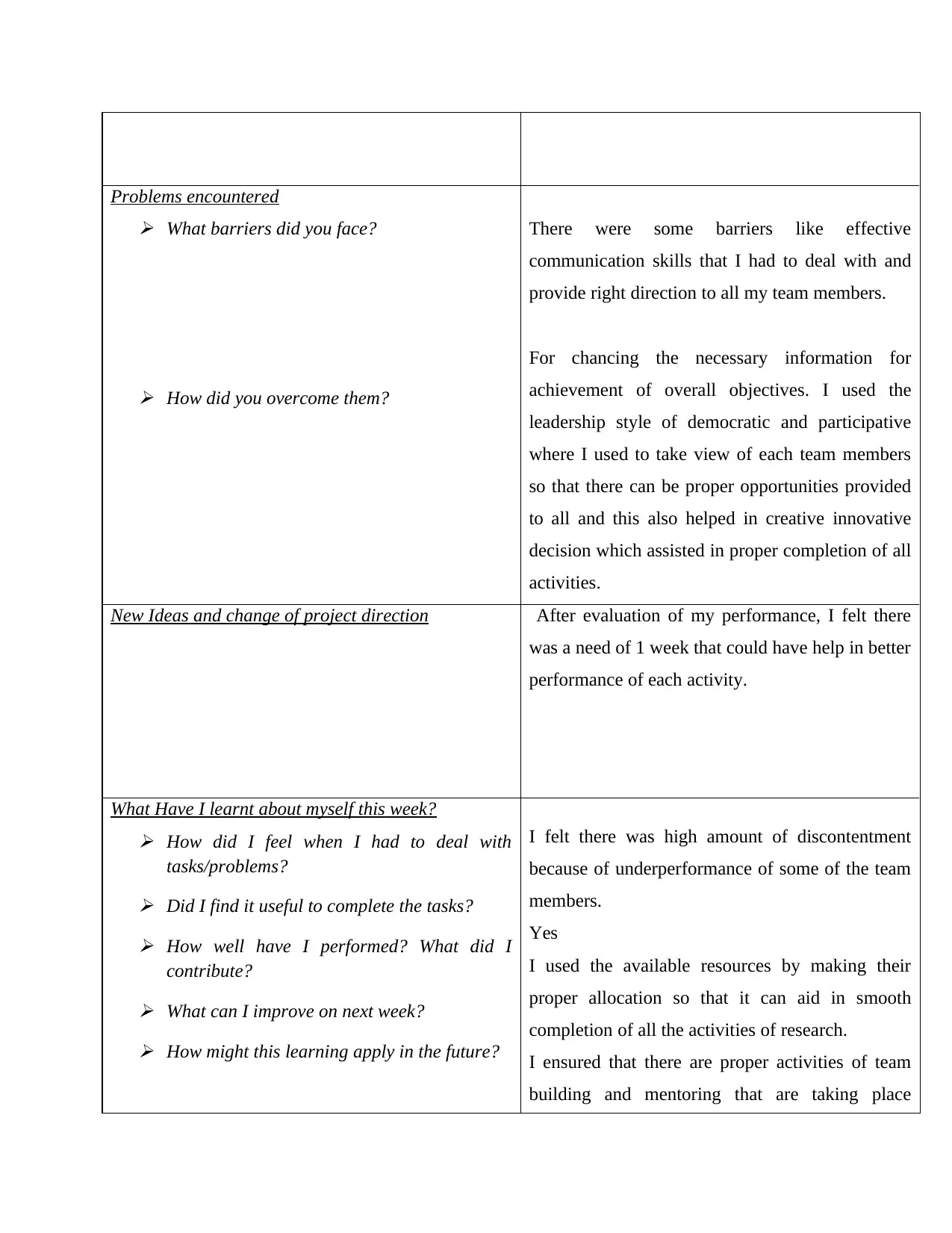
Problems encountered What barriers did you face?
How did you overcome them?
There were some barriers like effective
communication skills that I had to deal with and
provide right direction to all my team members.
For chancing the necessary information for
achievement of overall objectives. I used the
leadership style of democratic and participative
where I used to take view of each team members
so that there can be proper opportunities provided
to all and this also helped in creative innovative
decision which assisted in proper completion of all
activities.
New Ideas and change of project direction After evaluation of my performance, I felt there
was a need of 1 week that could have help in better
performance of each activity.
What Have I learnt about myself this week? How did I feel when I had to deal with
tasks/problems? Did I find it useful to complete the tasks? How well have I performed? What did I
contribute? What can I improve on next week? How might this learning apply in the future?
I felt there was high amount of discontentment
because of underperformance of some of the team
members.
Yes
I used the available resources by making their
proper allocation so that it can aid in smooth
completion of all the activities of research.
I ensured that there are proper activities of team
building and mentoring that are taking place
How did you overcome them?
There were some barriers like effective
communication skills that I had to deal with and
provide right direction to all my team members.
For chancing the necessary information for
achievement of overall objectives. I used the
leadership style of democratic and participative
where I used to take view of each team members
so that there can be proper opportunities provided
to all and this also helped in creative innovative
decision which assisted in proper completion of all
activities.
New Ideas and change of project direction After evaluation of my performance, I felt there
was a need of 1 week that could have help in better
performance of each activity.
What Have I learnt about myself this week? How did I feel when I had to deal with
tasks/problems? Did I find it useful to complete the tasks? How well have I performed? What did I
contribute? What can I improve on next week? How might this learning apply in the future?
I felt there was high amount of discontentment
because of underperformance of some of the team
members.
Yes
I used the available resources by making their
proper allocation so that it can aid in smooth
completion of all the activities of research.
I ensured that there are proper activities of team
building and mentoring that are taking place
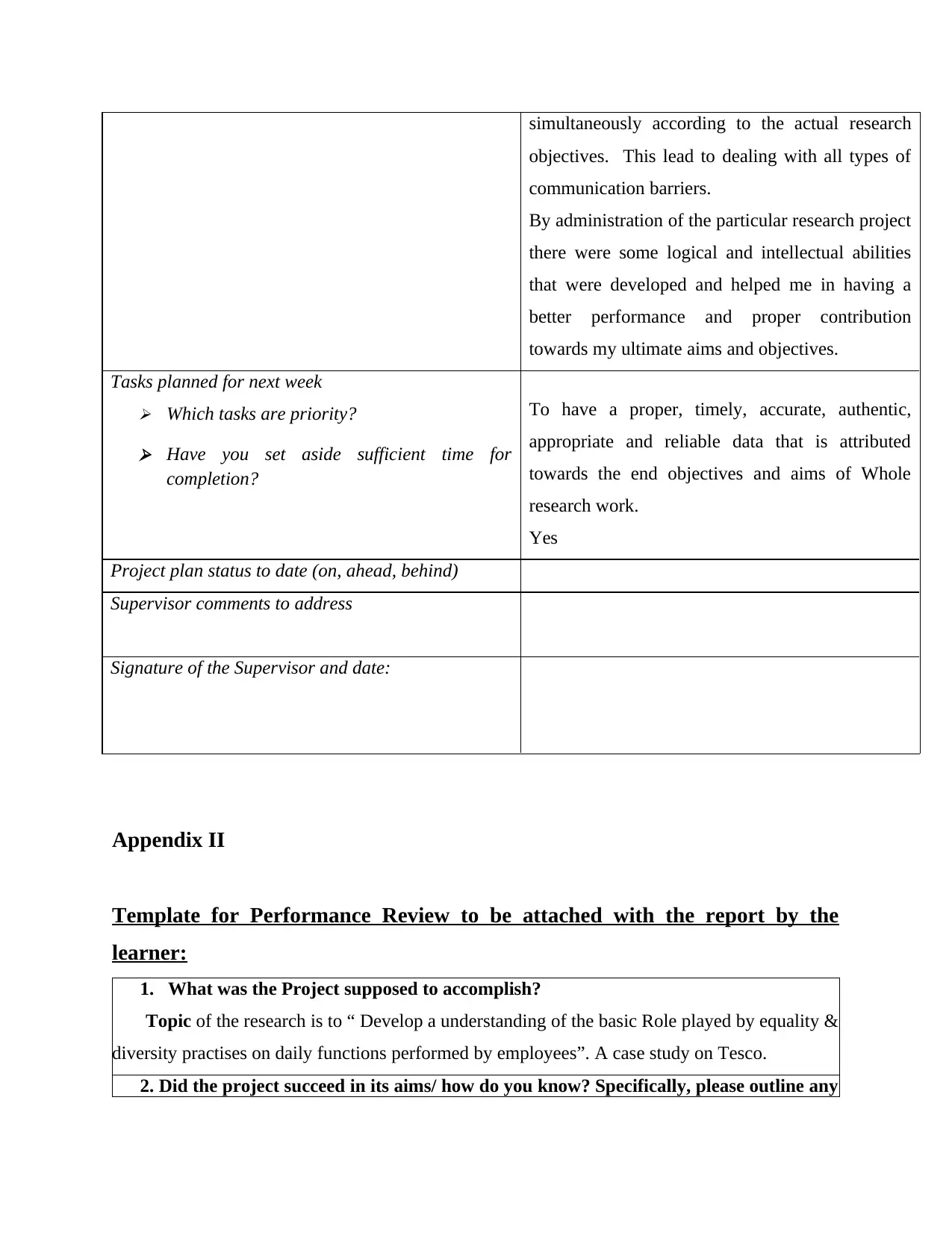
simultaneously according to the actual research
objectives. This lead to dealing with all types of
communication barriers.
By administration of the particular research project
there were some logical and intellectual abilities
that were developed and helped me in having a
better performance and proper contribution
towards my ultimate aims and objectives.
Tasks planned for next week Which tasks are priority? Have you set aside sufficient time for
completion?
To have a proper, timely, accurate, authentic,
appropriate and reliable data that is attributed
towards the end objectives and aims of Whole
research work.
Yes
Project plan status to date (on, ahead, behind)
Supervisor comments to address
Signature of the Supervisor and date:
Appendix II
Template for Performance Review to be attached with the report by the
learner:
1. What was the Project supposed to accomplish?
Topic of the research is to “ Develop a understanding of the basic Role played by equality &
diversity practises on daily functions performed by employees”. A case study on Tesco.
2. Did the project succeed in its aims/ how do you know? Specifically, please outline any
objectives. This lead to dealing with all types of
communication barriers.
By administration of the particular research project
there were some logical and intellectual abilities
that were developed and helped me in having a
better performance and proper contribution
towards my ultimate aims and objectives.
Tasks planned for next week Which tasks are priority? Have you set aside sufficient time for
completion?
To have a proper, timely, accurate, authentic,
appropriate and reliable data that is attributed
towards the end objectives and aims of Whole
research work.
Yes
Project plan status to date (on, ahead, behind)
Supervisor comments to address
Signature of the Supervisor and date:
Appendix II
Template for Performance Review to be attached with the report by the
learner:
1. What was the Project supposed to accomplish?
Topic of the research is to “ Develop a understanding of the basic Role played by equality &
diversity practises on daily functions performed by employees”. A case study on Tesco.
2. Did the project succeed in its aims/ how do you know? Specifically, please outline any
Secure Best Marks with AI Grader
Need help grading? Try our AI Grader for instant feedback on your assignments.
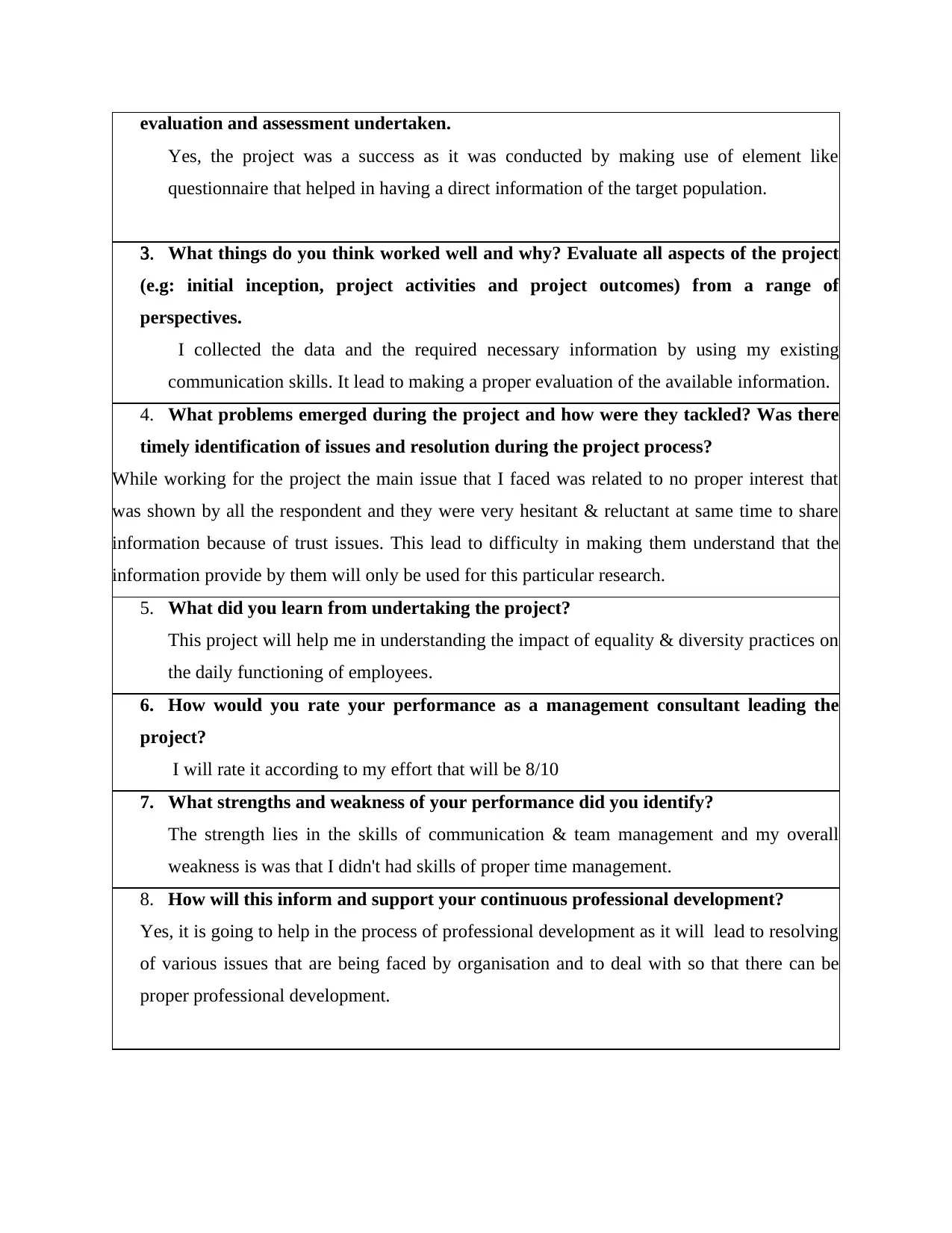
evaluation and assessment undertaken.
Yes, the project was a success as it was conducted by making use of element like
questionnaire that helped in having a direct information of the target population.
3. What things do you think worked well and why? Evaluate all aspects of the project
(e.g: initial inception, project activities and project outcomes) from a range of
perspectives.
I collected the data and the required necessary information by using my existing
communication skills. It lead to making a proper evaluation of the available information.
4. What problems emerged during the project and how were they tackled? Was there
timely identification of issues and resolution during the project process?
While working for the project the main issue that I faced was related to no proper interest that
was shown by all the respondent and they were very hesitant & reluctant at same time to share
information because of trust issues. This lead to difficulty in making them understand that the
information provide by them will only be used for this particular research.
5. What did you learn from undertaking the project?
This project will help me in understanding the impact of equality & diversity practices on
the daily functioning of employees.
6. How would you rate your performance as a management consultant leading the
project?
I will rate it according to my effort that will be 8/10
7. What strengths and weakness of your performance did you identify?
The strength lies in the skills of communication & team management and my overall
weakness is was that I didn't had skills of proper time management.
8. How will this inform and support your continuous professional development?
Yes, it is going to help in the process of professional development as it will lead to resolving
of various issues that are being faced by organisation and to deal with so that there can be
proper professional development.
Yes, the project was a success as it was conducted by making use of element like
questionnaire that helped in having a direct information of the target population.
3. What things do you think worked well and why? Evaluate all aspects of the project
(e.g: initial inception, project activities and project outcomes) from a range of
perspectives.
I collected the data and the required necessary information by using my existing
communication skills. It lead to making a proper evaluation of the available information.
4. What problems emerged during the project and how were they tackled? Was there
timely identification of issues and resolution during the project process?
While working for the project the main issue that I faced was related to no proper interest that
was shown by all the respondent and they were very hesitant & reluctant at same time to share
information because of trust issues. This lead to difficulty in making them understand that the
information provide by them will only be used for this particular research.
5. What did you learn from undertaking the project?
This project will help me in understanding the impact of equality & diversity practices on
the daily functioning of employees.
6. How would you rate your performance as a management consultant leading the
project?
I will rate it according to my effort that will be 8/10
7. What strengths and weakness of your performance did you identify?
The strength lies in the skills of communication & team management and my overall
weakness is was that I didn't had skills of proper time management.
8. How will this inform and support your continuous professional development?
Yes, it is going to help in the process of professional development as it will lead to resolving
of various issues that are being faced by organisation and to deal with so that there can be
proper professional development.
1 out of 23
Related Documents
Your All-in-One AI-Powered Toolkit for Academic Success.
+13062052269
info@desklib.com
Available 24*7 on WhatsApp / Email
![[object Object]](/_next/static/media/star-bottom.7253800d.svg)
Unlock your academic potential
© 2024 | Zucol Services PVT LTD | All rights reserved.





